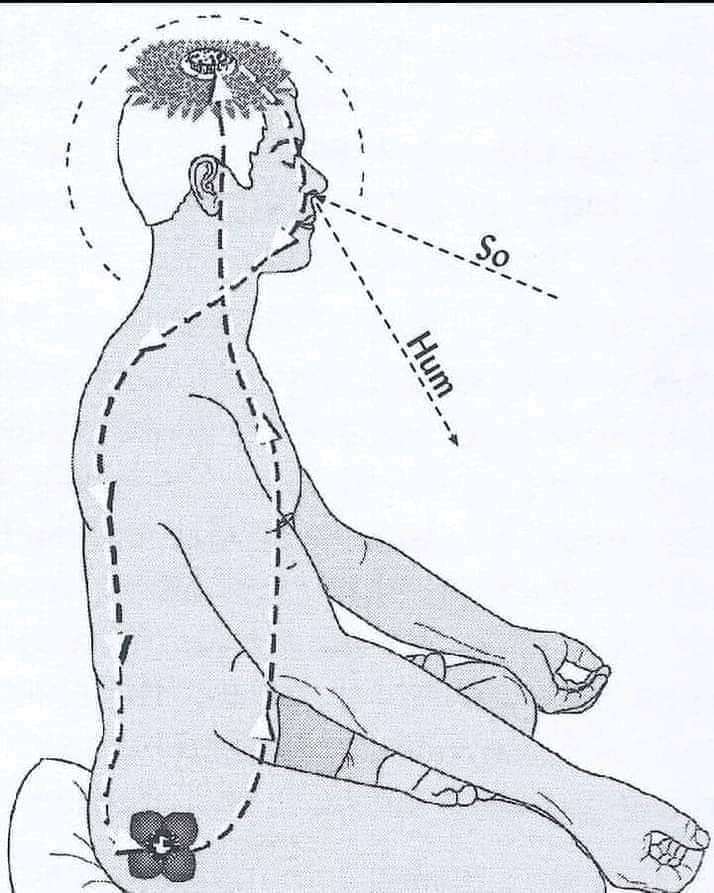Pranayam
Pran is the vital life force or energy.
Main Pran or Varishtha has five categories--Pran, Apan, Saman, Udan, Vyan.
- Pran is breathing. Location is Anahat Chakr. Sub Pran is Nag which causes hiccups.
- Apan is downward force e.g. waste elimination, sexual function. Muladhar Chakr. Sub pran is Kurma which induces hunger and thirst.
- Saman is gastric and abdominal function. Manipur Chakr. Sub pran is Krikara
- Udan is upward force e.g. coughing, sneezing. It takes Jiva to Brahman during sleep. At death it separates physical and astral bodies. It is located in Visshudhi Chakr. Sub pran is Devdatt which causes yawning.
- Vyan is distribution through arteries, nerves, veins etc.Swadhisthan Chakr. Sub pran is Dhananjay which causes decomposition of body after death.
As per Hath Yog Pradipika, there are 72,000 nadis in the human body. Shiv Samhita mentions 350,000 nadis. Pran circulates through these nadis. The main are Ida, Pingala, and Susumna. These are in the center of the back. Ida is on the left side and terminates in the left nostril. It is associated with the moon/Chandra and emotions. Pingala is on the right side and terminates in the right nostril. It is associated with the Sun/Surya. When Ida and Pingala are in balance, the pran flows upwards through the Susumna which is in the center.
There are four stages of breath- Poorak, Antar-kumbhka, Rechak, Bahya-kumbhaka. Pranayam practitioners use different ratios for these stages. Some examples are--1:0:1:0, 1:0:2:0, 1:1:1:0, 1:4:2:0, 1:4:2:2, 1:2:4:8, 1:4:4:8, 1:8:4:16, 1:16:4:32
Kaival Kumbhaka is a stage when the breath stops flowing. It is the ultimate goal. There are five obstacles before Keval Kumbhaka. These are- Avidhya, Raag, Dwesh, Asmita or Ego, and Abhinivesh or fear of death.
The nose has two nostrils which are separated from each other by the nasal septum. All five vital elements are represented in the nose. The tip of the nose represents the fire/Agni element. Both angles represent the water/Jal element. Sides are air/Vayu element or tatv. The septum is earth/Prithvi tatv. In the center of both nostrils is space/Aakash tatv. The goal is to make Pran flow through the Aakash tatv.
Pranayam is Pran plus Ayam. It means managing or controlling pranic activities. Prana and Yama(to control), Pran and Ayama(to expand).
Pranayam and Yog are not exercises. In Pranayam, breathing is deeper and slower. In exercises, breathing is swallow and fast.
Pranayam is slowing down of inhalation and exhalation. It is a stage when breath becomes subtle. When breath becomes subtle then the hyperactive mind can be controlled. It purifies the mind and cleanses seventy-two thousand channels of energy. It makes us calmer and gentler.
तस्मिन् सति श्वासप्रश्वास्योर्गतिविच्छेदः प्राणायामः ॥2-४९॥(patanjali Yog Sutr)
It has three sopans- Bahya, abhyanter or internal, and sthambh or cessation. Bahya is prakriti (Greed, Attachment, anger), Abhyanter (Vivek, vairagya, sham, dambh). Count how many times chit goes to bahay and abhyanter vriti and try to bring it back to stambh vriti. Third sopan of pranayam is when chit stops going to bahya and abhyanter vritis.Pranayam is done to transcend the Pran that invades everything.
Place of breath is called desh, duration is kaal, number is sankhya. It has to be long or dirgh and subtle or sukshma.
बाह्याभ्यन्तरस्थम्भ वृत्तिः देशकालसन्ख्याभिः परिदृष्टो दीर्घसूक्ष्मः ॥2-५०॥
बाह्याभ्यन्तर विषयाक्षेपी चतुर्थः ॥५१॥The fourth transcends the external and internal as an object.
ततः क्षीयते प्रकाशावरणम् ॥५२॥From that, the covering of the light dissolves.
धारणासु च योग्यता मनसः ॥५३॥And fitness of the mind for concentration.
Pranayam Mantr:
प्राणस्येदं वशे सर्वं त्रिदिवे यत् प्रतिष्ठितम्।
मातेव पुत्रान् रक्षस्व श्रीश्च प्रज्ञां च विधेहि न इति ॥
Prashna Upnishad 2.13
'यह सम्पूर्ण विश्व, यहाँ तक कि जो कुछ स्वर्गों में प्रतिष्ठित है, वह सब 'प्राण' के वश में है; जिस प्रकार माता अपने नन्हें पुत्रों की रक्षा करती है, उसी प्रकार हमारी रक्षा करिये; हमें सौभाग्य एवं सौन्दर्य (श्री) प्रदान करिये, हमें प्रज्ञा दीजिये।'''
PRANASYEDAM VASE SARVAM, TRIDIVE YAT PRATISTITHAM.
MAATEVA PUTRAN RAKSJASVA, SREESCHA PRAGNAMCHA VIDEHINA ITI
What ever exists in three worlds, Is all under the control of Prana. Hey Prana, Please protect us as a mother protects her sons. Give us affluence and intelligence.
everything of enjoyment in this world, is under the control of Prana; as also of all that which exists in the third heaven for the enjoyment of the Devas, etc., Prana alone is the lord or protector. Therefore, protect, as a mother does her sons. As all splendour pertaining to a Brahmin and Kshatriya are due to you, give us that affluence and knowledge originating in you. It has been thus determined that Prana whose greatness or glory, as being all, has thus been disclosed by the eulogy of the pranas; such as speech and the rest is the lord of the creation, the eater.
चले वाते चलं चित्तं निश्चले निश्चलं भवेत् | हठयोगप्रदीपिका |२| |२|
when Prana (Breath) moves Chitta (The Mental force) moves, When Prana is without movement, Chitta is without movement. ~ (Hatha Yoga Pradipika- 2/2).
Different types of Pranayam are:
- Surya(right nostril) and Chandra (Left nostril) Anulom Vilom or Nadi Shuddhi-- Be careful if you have deviated nasal septum or if one nostril is completely blocked or in case of severe nasal congestion and obstruction due to any cause.
- Surya and Chandra Bhedana
- Kapalbhati-- Kapal means forehead, Bhati means glow. It involves active (not rapid or forceful) exhalation/rechak through the nostrils. Inhalation/poorak happens passively. Mouth is kept closed. Recommendations are to practice this on an empty stomach. Best position for kapalbhati is vajrasan or padmasan and hands in aadi mudra. Lower abdominal muscles and diaphragm mainly work in this kriya. Moolbandha feeling comes with correctly done kapalbhati. This practice empties the lungs of air (from deep within the alveoli) which is rich in carbondioxide. At the end of Kriya the lungs then get filled with pure air rich in oxygen. Because of increased oxygen levels, kapal glows.
Kapalbhati is a kriya as well as a pranayam. Kriya as it is an exrcise/process. Pranayam as it involves control of breaths.
Gherandsamhita describes Kapalbhati in its first chapter:
Vatkramen vyutkramen shitkramen visheshatah |
Bhalbhatim tridha kuryat kaphadosham niwaryet || G S 1.54
Meaning -
There are three types of Kapalbhati - Vatkrama, Vyutkrama and Sheetkram. By performing kapalbhati doshas of kapha are eliminated.
The next shloka describes Vatkram Kapalbhati.
Idaya purayedwayum rechayetpingalaya |
Pingalaya puryitwa punashchandren rechayet || G S 1.55
Meaning -
The air should be inhaled with Ida Nadi ( left nostril ) and exhaled through Pingala Nadi ( right nostril ). Again the process should be performed in a reverse manner.
Poorakam rechakam krutva vegen na tu dharayet |
Evambhyasyogen kaphadosham niwaryet || G S 1.56
Meaning -
Pooraka and Rechaka should be performed rapidly, without performing Kumbhaka. This eliminates kapha doshas.
Then Vyutkrama and Sheetkrama Kapalbhatis are described. However, we see them under the chapter Neti.
Hathyogpradeepika have also described Kapalbhati.
Bhararyavallohakarsya renchapuro sasambhramou |
Kapalbhativikhyata kaphadosha vishoshani || 2-35
Meaning -
When Pooraka and Rechaka are performed rapidly as in bellows of a blacksmith. It is known as Kapalbhati. The study of Kapalbhati reduces kapha doshas.
Both Gherandsamhita and Hathyogpradeepika agree that the practice of Kapalbhati eliminates kapha doshas. Hathyogpradeepika describes the process in detail. And the simile used by them is very apt in the sense that if one observes the movement of the bellows, the fan is pressed to release the air out with force and then loosened to let the air in with natural ease. Similarly, a forceful rechaka and natural pooraka with rapid movement is expected in Kapalbhati.
For COPD/asthma patients, the respiratory drive is hypercapnia. These patients need to observe caution regarding the frequency and intensity of kapalbhati.
This practice may momentarily lead to decreased oxygenation, as the time for oxygenation is small and inhalations are not deep or full. Patients who are anemic should be careful.
In cases of hypoxia- hypoxic, anemic, or histotoxic, expert advice is needed.
- Bhastrika--Chandranga and Sooryanga
- Agnisar
- Sadanta(Close the teeth over each other gently, tip of the tongue is on the back side of lower front teeth. Inhale from mouth and exhale through nostrils), Sheetali (Roll the tongue from sides like a tube, take it out of mouth a little bit, inhale from mouth, feel the cool air and exhale from the nose), and Shitkari ( roll tongue upwards towards upper palate, inhale from the mouth from the sides of teeth and exhale from the nose) Pranayam. Sheet means cool.
Avoid these practices in tonsillitis, infections in mouth, and cold weather. - Kechari Pranayam
- Shanmakhi Pranayam- Place thumbs over the tragus of ears, index fingers close the eyes gently (do not press the eyelids hard), middle fingers close the nostrils during antar and bhay kumbhak, ring finger is above the upper lips and little finger under the lower lips. Rest is same as Brahamari.
- Brahamari- It helps in Pratyahar. So the practice involves closing the sense organs (ears, eyes, nose, and mouth). In simple Brahamari, place both thumbs over the tragus of ears and close ears, ring and midle fingers close the eyes gently, index fingers are above the eyelids and little fingers are below the lower part of eyes. Inhale through nostrils, exhale Om from throat and make a humming sound which vibrates all over the face and head. At the end of exhale, do not tense the neck muscles, start vibrations from the head and keep the tip of tongue on the hard palate. Vibrations increase the blood flow in brain. Caution is needed in patients with HTN, increased intracranial pressure, etc.
- During Brahmari, focus on Ajna chakr. In silent Brahamari, imagine that you are making a humming sound and feel the vibrations. Shanmukhi is advanced Brahamari.
- Ujjayi Pranayam
- Vibhagiya Pranayam or sectional breathing
- Swar Yog
Shiv Swarodaye Shastra (शिवस्वरोदय:) explains the Swar Yog/Vidya. It has 395 Sutrs. It is the vaartalap between Shiv and Parvati in which Shiv gives this gyan to Parvati. It has Tattv Gyan also. Swar Vidya is also known as Mahakaal Vidya, as Kaal can be modified and predicted by it.
Ahata is the aloud chanting. Anahata is silent chanting.
Bandhas:
-
Mool - Root lock. Its physical aspect is Pubo coccygeal muscle. Its goal is to prevent the downward escape of energy.
-
Uddiyan- At Abdominal level. Its physical aspect is Transversus abdominis and Iliopsoas muscle. Abdomen is tucked in and lifted up (uddiyan means going up). Ribs become prominent and abdominal area appears as a cavity.
There is no contraction of Rectus abdominis, External oblique and Internal oblique. These three muscles are relaxed. If Rectus abdominis is contracted, Uddiyan bandha will not happen. Transversus abdominis(deepest layer) contracts. Hollow is created between two hips.
This bandha or lock involves the movement of the muscles of the abdomen and especially the diaphragm. Hatha Yoga assigns a special importance to Uddiyan Bandha and the study of pranayama is not complete without studying this lock. While performing this lock the muscles of the diaphragm are pulled in an upward direction; Uddiyan in Sanskrit is moving up hence this bandh is termed as Uddiyan Bandha. This lock is also useful for awakening of Kundalini Shakti which is another reason the name is there, for raising the energy upward.
The lock involves the action of the muscles of the abdomen and hence it may be performed while in a standing pose or sitting pose. The bandha can also be performed in Padmasan, Siddhasan, Vajrasan or any other meditative asana. However for best results, and especially when learning, it is best to perform the lock in a standing position.
PRACTICING THE BANDHA:
Stand with a distance of 1 to 1.5 feet between the legs.
Bend the knees as if one is about to sit in a chair and place the palms firmly on the knees. The pressure should be on the arms so that the abdomen can relax.
Bend the shoulders a little towards the front and the neck slightly downward.
Inhale deeply and then exhale either through the nose or mouth. While exhaling, try to pull the muscles of the abdomen inwards. Lift up the ribs a little bit and pull the muscles from within with a gentle push upwards. The muscles of the abdomen must be relaxed at this time, so that they can be pushed up. These results in the muscles of the diaphragm being pushed upwards and a vacuum created in abdomen. This is the final stage of Uddiyan Bandha.
Try to remain firmly in this pose for as long as one can hold the breath out comfortably.
When one needs to inhale slowly release the bandha by releasing the muscles of the abdomen back to the normal position. The diaphragm will also be restored to its normal position.
Relax the strain in the shoulders and neck area and start inhaling gradually.
After inhaling completely, bring the arms by the side and straighten the legs.
For learning uddiyana bandha, you will ordinarily stand with your knees slightly bent and brace your hands against the thighs. This stance develops a downward and forward movement of the abdominal organs, which you counteract in the abdominal lift. You can do all of this in practically any upright position, but the classical stance allows you to detect errors more easily and make internal corrections.
Exhale completely. Notice that you do this pressing in with both your chest and abdomen. You can pretend to be blowing up a balloon as much as possible with one breath.
Do a mock inhalation using your chest, locking your glottis and restraining air from entering your lungs, and at the same time relax your abdomen. If you get confused about how to prevent air from entering your lungs, you can try to inhale (without inhaling) while blocking your mouth and nose with your hands. You should feel your chest lift.
Holding the breath, try harder to inhale while keeping your abdomen relaxed. Your upper abdomen will form a deep concavity that extends up underneath your rib cage. This is uddiyana bandha.
Relax your mock inhalation, letting your chest and abdominal organs drop and your abdomen release forward.
Press gently in with your chest and abdomen, thus equalizing air pressure on the inside and outside of the body, and gently inhale without gasping.
ADDITIONAL HINTS
If you hold your breath at your glottis on the exhalation, it will be more comfortable to drop your chin toward or into the little concavity just above your sternum. This is jalandhara bandha, the chin lock.
Another lock that often goes nicely with this practice is mula bandha, the root lock, in which you tighten up the muscles around the base of the body, much as you would if you needed to restrain a bowel movement in diarrhea. Don’t attempt it until uddiyana bandha comes easily. If you have difficulty relaxing your abdomen and letting it be pulled in and up by the action of your chest, trying to do the root lock will only create confusion.
TROUBLESHOOTING
If you are having trouble, one of three things may be wrong:
You are not exhaling enough at the beginning. The less you exhale, the less convincing will be the lift.
You are letting a little air in on your mock inhalation. You have to try to inhale without doing so. That is the whole point of locking your airway at the glottis or of holding your nose and mouth at the end of the exhalation.
You are not relaxing your abdomen during the mock inhalation. This is the most common fault. Many students hold their abdominal muscles rigidly or even mistakenly try to keep pushing in with them. If you keep them tight, the abdominal organs and abdominal wall cannot be sucked in and up.
Confusion is common because the abdominal muscles can operate in several ways. Many students succeed in relaxing the abdominal muscles momentarily, and then get confused and try to aid the inward movement with an active contraction. They have already exhaled, but they try to exhale more, probably because they associate a demand for concentration with tight abdominal muscles. It is a natural response, but out of place here. You must distinguish between pressing in with the abdominal muscles (which you do only during the preliminary exhalation) and allowing the abdominal wall to be pulled in passively by the vacuum in the chest.
The vacuum that creates the bandha comes from expanding the rib cage. Because no air is allowed in, the pressure inside decreases, creating a mild vacuum which lifts up on the relaxed diaphragm and the abdominal organs. When you release the lock, the expansion of the rib cage is relaxed and the diaphragm and abdominal organs settle back down.
What apparently prevents many people from letting go of the abdominal muscles is an unconscious fear reaction. (If you pretend a feeling of apprehension, you’ll feel tightening in the most vulnerable part of your body—your belly.) To learn uddiyana bandha, you have to release and relax.
If you still are having trouble, purse your lips while leaving a small orifice, and create a gentle suction to draw air in. Close your eyes. Feel what is happening. Notice that you do this with the entire torso, and that it would be unthinkable to do it except after exhalation. (You would not suck liquid up a straw after a full inhalation.) Notice also that you have to prevent air from entering your lungs from your nose. Anyone who has ever sucked on a straw does that naturally. What has happened in this exercise (in contrast to uddiyana bandha) is that the abdominal muscles remain in a state of contraction by creating a rigid tubular structure, which holds its shape even though the chest has developed a substantial vacuum.
Now, try the same exercise, but this time relax the abdominal muscles completely as you draw air in through your pursed lips. You create a vacuum as before in the chest, but this vacuum is now translated to the abdominal wall, which yields. It is sucked in and the abdominal organs are lifted up by the vacuum in the chest. If you do this maneuver without permitting any air to enter, you will be doing uddiyana bandha.
One of the most helpful postures for those who have difficulty relaxing their abdominal muscles is a modification of the cat stretch. Rest on your knees and forearms and drop your head down against your hands. This pitches your abdominal organs forward and toward your chest. Now all you have to do is exhale as much as possible and hold your breath. Notice that it is unnatural to hold the abdominal muscles tightly in this posture, and that the abdominal lift occurs naturally and gracefully. Then, holding your breath and keeping the feeling of rib cage lift and abdominal relaxation, slowly lift your head and shoulders, carefully come up on your hands, and then ever so delicately come into a kneeling position. Coming up without tightening your abdominal muscles may require some practice.
The hollow belly of Uddiyana Bandha can be approximated in a reclining position. Technically this position is called Tadagi Mudra, the Tank Seal (tadagi = tank), because the hollow belly is reminiscent of a water tank. Lie on your back and stretch your arms overhead, laying the backs of the hands on the floor. Extend through your heels in the opposite direction. The opposing stretch of the arms and legs sucks the belly into the torso, shaping it like a water tank or pool. Don’t, however, hold the breath; breathe normally, allowing the upper belly to expand fully on the inhalation, while keeping the lower belly hollow.
Optional but strongly recommended – after completion of Uddiyan bandha lie in shavasan and very gently press the abdomen, in the direction of the large intestine. This helps to relax the abdomen.
BENEFITS FOR WOMEN: Tones the reproductive organs, regulates the menstrual cycle.
VARIATION -when releasing the bandha one may inhale, raising the arms up over the head and exhaling lowering the arms down. This can be helpful if there is any tension in the neck.
ANATOMICAL FOCUS: Abdomen being pulled in and up
AWARENESS: Manipur chakra, Navel region, external breath retention, relaxation, stillness
DO'S: Try to relax as much as possible to hold the bandha longer, have a slight hunch in upper back, bend neck forward like Jalandhar bandha, but not contracting the throat.
DON'T: Have any strain, hold so long that there is tension in the throat, resulting in coughing
BENEFITS: The muscles of the diaphragm are well exercised and this movement therefore helps improve breathing.
The organs in the abdomen develop a negative pressure. Due to this pressure, the blood supply to these organs is improved. The difference between the negative pressure during this bandh and the normal pressures resumed after relaxation increases friction on the internal organs such as the stomach, small intestines, liver and pancreas thereby improving their efficiency. This also results in improving the secretion of the digestive juices, improving the digestive function.
It is stated in various ancient texts that apart from these benefits, the bandh is also useful for spiritual progress and awakening of Kundalini power.
It is very important for practice this bandha independently as a preparation for tribandha and pranayama.
Stimulates the digestive fire and appetite is stimulated.
Tones liver, pancreas, adrenals, urinary and excretory systems. Removes impurities and improves the efficiency of all the organs.
Excellent practice for helping depression, also removes fatigue and lethargy.
Stimulates vagus nerve which is stimulation to parasympathetic nervous system and that brings mental, physical relaxation and peace.
Improves blood supply throughout the whole torso.
Reverses the flow of apana and prana, causing union with samana and maipur chakra.
Stimulation of manipur chakra, the energy distribution centre, increases pranic energy.
Balances all 5 pranas in the body.
THERAPEUTIC APPLICATIONS: Diabetes, low appetite, weight loss, poor digestion and malabsorption, flatulence, depression, stress, and anxiety, Reproductive problems.
PRECAUTIONS & CONTRA-INDICATIONS: Avoid if there has been any abdominal surgery, high blood pressure, heart disease, ulcers, diarrhoea, menstruation, hernia, intracranial pressure, glaucoma, pregnancy or acidity. Always practice on an empty stomach and if possible, empty bladder and bowels.
DURATION: 3-5 rounds can be practiced, holding for 10 seconds or as long as is comfortable. Slowly the time duration can be increased up to 1 minute.
VARIATIONS & TIPS: Sometimes making a false inhalation by trying to expand the chest as if one is breathing in Uddiyan bandha can help improve the bandha as it helps to pull the diaphragm upwards.
PREPARATORY POSES: Agnisar Dhouti
FOLLOW UP PRACTICES: Tribandha and pranayam
REFERENCES IN THE ANCIENT TEXTS:
The third chapter in the Hatha Yoga Pradipika describes ten mudras. Uddiyan bandh has been described as one of the mudras. The writer of Hatha Yoga Pradipika explains why this mudra is termed as Uddiyan bandha as follows :
Badhho yen sushumnayam pranastuddiyate yatah |
TasmadUddiyanakhyoyam yogibhihi samudahrutah||3-55
Meaning -The prana in the body is raised due to the performance of this bandha, hence this bandha is termed as Uddiyan bandha.
The action of this bandh is described below :
Udare paschimam tanam nabherudhwaram cha karayet
Uddiyano hyasou bandho mrityumatang kesari || 3-57
Meaning -
The abdomen is to be pulled (stretched) inwards and the navel upwards. This process is known as Uddiyan bandha. This action is like a lion killing an elephant which represents death. Nowhere in the process is it described that the bandha is to be performed after exhalation. This part was taught as a matter of master–disciple tradition and hence perhaps not explained in detail in the shloka.
The effects of this bandh have been described below:
Uddiyanam tu sahajam gurunam kathitam sada |
Abhyasetsatatam yastu vruddhopi tarunayate || 3-58
Meaning -
If the bandha is practised constantly and regularly as taught by the Guru, even an old man can be reverted into a young one. The effects have been a bit exaggerated however the hidden meaning is to be understood. The bandha causes certain beneficial effects on the body, which in turn result in a youth like state of the body, full of enthusiasm.
The next shloka describes:
Nabherurdhwamadhaschapi tanam kuryatprayatnatah |
Shanmasbhyasenmrutyum jayatyeva na samshayah || 3-59
Meaning -
If a sadhaka practices stretching the navel, the portion below the navel and the upper part of the abdomen towards the back and upward direction regularly for a period of six months, there is no doubt that he can win over death. This description is also a bit exaggerated however the logic behind it must be understood. We should not blindly believe that practising this bandah for six months will win over the death, but we should still practice this bandha regularly so that its beneficial effects on the body will result in increasing our life span. A shloka after this describes that the study of this bandha results in leading the sadhaka easily onto the path of mukti (liberation). -
Jalandhar- At throat level. SIt straight. Take a deep inhale. Hold the breath. Now, raise the chin without tilting the head and then bend forward and turn the head and neck downwards towards the sternum. Lift sternum/chest up towards chin. Neck is flexed and thoracic/lumbar spine is extended. Hold the breath in this position. Release the position and exhale slowly.
-
This bandha happens between poorak and rechak.
What muscles contract to bring our chin to our chest or lift our chest to our chin?
Sternocleidomastoids
Anterior scalenes
The breath itself will lift the chest (through the action of the diaphragm and intercostals) as the breath expands the lungs and the rib cage expands and lifts on the inhale
The deep paraspinal muscles like multifidus would contribute to spinal extension
The erector spinae muscles would also contribute to spinal extension
Muscles that might restrict the jalandhara bandha position include:
Splenius capitis
Splenius cervicis
Upper trapezius
Suboccipitals
Pectoralis minor
Tight abdominals, especially rectus abdominis, could keep the whole torso flexed
You could even trace difficulty with the position of jalandhara bandha all the way to the hamstrings. Tight hamstrings could keep the pelvis pulled under, which could in turn create tension in abdominals to keep yourself sitting upright. That tension in the abdominals will make it difficult to sit upright enough to bring the chest up towards the chin. Finally those tight muscles on the back of the neck can interfere with comfortably bringing the chin to the chest, including the upper trapezius.
Jalandhar Bandha can be used with Padmasan, Dandasan, Baddha konasan, Shoulder stand, and Karnapidasana.
When we create the intention of jalandhara bandha, we are compressing the visceral compartment of the neck. This compartment contains important structures in the endocrine system (thyroid, parathyroid, and thymus), the respiratory system (larynx and trachea), and the digestive system (the pharynx). In the commentary, Hatha Yoga Pradipika relates jalandhara bandha to control of the endocrine system, especially the parathyroid glands, thyroid gland, and the pituitary gland. Remember that the endocrine system is our system of chemical messengers called hormones that help regulate everything from growth to sleep to our response to fear.
Jalandhar bandh expands the ribcage and therefore allows for more inhaled air to stay in lungs. This in turn increase the oxygen reserve for sternuous activities. It also helps in long antar kumbhak after inhale.
“The word jalandhara is from jala meaning liquid and dhara meaning to hold. The implication of the word liquid is that it has a tendency to spread. The reference is not to liquid, but to all sensations and sensory inputs, which spread from the sense in the head, and from there, into the body. Since the head holds all the sensations, the head itself is called jalandhara. The word bandh, as noted earlier, means to bind. Thus, this bandha helps to bind the essence of all the sensations.”
In this bandha, the network of energy channels or nadis of the body is locked.
The bandh has been described in Hathapradeepika in the third chapter as under :
Kanthamakunchya hridaye sthapayechhibukam dridham |
Bandho jalandharakhyoyam jaramrituvinashakah || H P 3-70
Badhnani hi shirajalam adhogami nabhojalam |
Tato jalandharo badhah kanthadukkhahoghanashanah || H P 3-71
Meaning -
The chin is to be pressed on the chest after contracting the throat. This bandh eliminates old age and death. The contracted veins in the throat ensure that the liquid from the skies is received here. Hence, the bandh has been appropriately known as Jalandhar Bandh, which means that it destroys any pain in the throat.
Gherandsamhita has also described the bandh as under :
Kanthasankochanam krutva chibukam hridaye nyaset |
Jalandharakrute bandhe shodashadharbandhanam |
Jalandharam mahamudra mrityoeach kshayakarini || G S 3-12
Meaning -
The chin is to be pressed onto the heart after contracting the throat. This Jalandhar Bandh supports sixteen types of bandhas and destroys death.
Siddham jalandharam bandham yoginam siddhidayakam |
Shanmasmabyaset yo hi sa siddho natra samshayah || G S 3-13
Meaning -
Jalandhar Bandh is Swayamsiddha and the sadhaka who practises this bandh for six months will, no doubt, achieve siddha status.
Mudras:
- Chinh mudra-- thumb and index finger touch each other. Middle, ring, and little fingers are straight and stretched out. Hands are on knees in padmasan or sukhasan or singhasan.
- Aadi mudra-- thumb is folded in loose fist. Four fingers are covering thumb.
- Brahm mudra-- thumb is inside fist. Fingers cover thumb. Knuckles of both hands touch each other. Palm side of hands are up. Hands are on navel.
Pranayam and lungs:
Four parts of breathing practices:
-
Deep and Slowness
-
Synchronization
-
Awareness
-
Exhalation longer than inhalation
-
With abdominal breathing lower parts of lung are activated--Adham pranayam
-
With chest or thoracic breathing, middle part of lung is activated--Madhyam pranayam
-
With clavicular breathing, upper part of lung is activated--Adya Pranayam
-
Yogic breathing--all parts of lungs are activated
Practice deep inhale by paying attention to expansion of lungs-
- Downwards and upwards towards collar bones
- Forwards and backwards
- Sidewords
During exhalation slowly exhale from these parts one by one.
Try to close the eyes and ears, and pay attention to the inhales and exhales.
Yogi conquers aging through pranayam. As long as one is calm, is focusing, and holding the breath, he has no fear of death.
Hathyog Pradipika chapter 2:
अथासने दॄधे योगी वशी हित-मिताशनः |
गुरूपदिष्ह्ट-मार्गेण पराणायामान्समभ्यसेत || १ ||
Posture becoming established, a Yogî, master of himself, eating salutary and moderate food, should practise Prâṇâyâma, as instructed by his guru.
छले वाते छलं छित्तं निश्छले निश्छलं भवेत||
योगी सथाणुत्वमाप्नोति ततो वायुं निरोधयेत || २ ||
Respiration being disturbed, the mind becomes disturbed. By restraining respiration, the Yogî gets steadiness of mind
यावद्वायुः सथितो देहे तावज्जीवनमुछ्यते |
मरणं तस्य निष्ह्क्रान्तिस्ततो वायुं निरोधयेत || ३ ||
So long as the (breathing) air stays in the body, it is called life. Death consists in the passing out of the (breathing) air.It is, therefore, necessary to restrain the breath मलाकलासु नाडीष्हु मारुतो नैव मध्यगः |
कथं सयादुन्मनीभावः कार्य-सिद्धिः कथं भवेत || ४ ||
The breath does not pass through the middle channel (suṣumnâ), owing to the impurities of the nâdîs. How can then success be attained, and how can there be the unmanî avasthâ.
शुद्धमेति यदा सर्वं नाडी-छक्रं मलाकुलम |
तदैव जायते योगी पराण-संग्रहणे कष्हमः || ५ ||
When the whole system of nâdîs which is full of impurities, is cleaned, then the Yogî becomes able to control the Prâṇa.
पराणायामं ततः कुर्यान्नित्यं सात्त्विकया धिया |
यथा सुष्हुम्णा-नाडीस्था मलाः शुद्धिं परयान्ति छ || ६ ||
Therefore, Prâṇâyâma should be performed daily with sâtwika buddhi (intellect free from raja and tama or activity and sloth), in order to drive out the impurities of the suṣumnâ.
Method of performing Prâṇâyâma.
बद्ध-पद्मासनो योगी पराणं छन्द्रेण पूरयेत |
धारयित्वा यथा-शक्ति भूयः सूर्येण रेछयेत || ७ ||
पराणं सूर्येण छाकॄष्ह्य पूरयेदुदरं शनैः |
विधिवत्कुम्भकं कॄत्वा पुनश्छन्द्रेण रेछयेत || ८ ||
Sitting in the Padmâsana posture the Yogî should fill in the air through the left nostril (closing the right one); and, keeping it confined according to one's ability, it should be expelled slowly througśanaiḥ |h the sûrya (right nostril). Then, drawing in the air through the sûrya (right nostril) slowly, the belly should be filled, and after performing Kumbhaka as before, it should be expelled slowly through the chandra (left nostril).
येन तयजेत्तेन पीत्वा धारयेदतिरोधतः |
रेछयेछ्छ ततो|अन्येन शनैरेव न वेगतः || ९ ||
Inhaling thus through the one, through which it was expelled, and having restrained it there, till possible, it should be exhaled through the other, slowly and not forcibly.
पराणं छेदिडया पिबेन्नियमितं भूयो|अन्यथा रेछयेत
पीत्वा पिङ्गलया समीरणमथो बद्ध्वा तयजेद्वामया |
सूर्य-छन्द्रमसोरनेन विधिनाभ्यासं सदा तन्वतां
शुद्धा नाडि-गणा भवन्ति यमिनां मास-तरयादूर्ध्वतः || १० ||
If the air be inhaled through the left nostril, it should be expelled again through the other, and filling it through the right nostril, confining it there, it should be expelled through the left nostril. By practising in this way, through the right and the left nostrils alternately, the whole of the collection of the nâdîs of the yamîs (practisers) becomes clean, i.e., free from impurities, after 3 months and over.
परातर्मध्यन्दिने सायमर्ध-रात्रे छ कुम्भकान |
शनैरशीति-पर्यन्तं छतुर्वारं समभ्यसेत || ११ ||
Kumbhakas should be performed gradually 4 times during day and night, i.e., (morning, noon, evening and midnight), till the number of Kumbhakas for one time is 80 and for day and night together it is 320.
कनीयसि भवेद्स्वेद कम्पो भवति मध्यमे |
उत्तमे सथानमाप्नोति ततो वायुं निबन्धयेत || १२ ||
In the beginning there is perspiration, in the middle stage there is quivering, and in the last or the 3rd stage one obtains steadiness; and then the breath should be made steady or motionless.
जलेन शरम-जातेन गात्र-मर्दनमाछरेत |
दॄढता लघुता छैव तेन गात्रस्य जायते || १३ ||
The perspiration exuding from exertion of practice should be rubbed into the body (and not wiped), as by so doing the body becomes strong.
अभ्यास-काले परथमे शस्तं कष्हीराज्य-भोजनम |
ततो|अभ्यासे दॄढीभूते न तादॄङ-नियम-गरहः || १४ ||
During the first stage of practice the food consisting of milk and ghee is wholesome. When the practice becomes established, no such restriction is necessary.
यथा सिंहो गजो वयाघ्रो भवेद्वश्यः शनैः शनैः |
तथैव सेवितो वायुरन्यथा हन्ति साधकम || १५ ||
Just as lions, elephants and tigers are controlled by and by, so the breath is controlled by slow degrees, otherwise (i.e., by being hasty or using too much force) it kills the practiser himself.
पराणायामेन युक्तेन सर्व-रोग-कष्हयो भवेत |
अयुक्ताभ्यास-योगेन सर्व-रोग-समुद्गमः || १६ ||
When Prâṇayama, etc., are performed properly, they eradicate all diseases; but an improper practice generates diseases.
हिक्का शवासश्छ कासश्छ शिरः-कर्णाक्ष्हि-वेदनाः |
भवन्ति विविधाः रोगाः पवनस्य परकोपतः || १७ ||
Hiccough, asthma, cough, pain in the head, the ears, and the eyes; these and other various kinds of diseases are generated by the disturbance of the breath.
युक्तं युक्तं तयजेद्वायुं युक्तं युक्तं छ पूरयेत |
युक्तं युक्तं छ बध्नीयादेवं सिद्धिमवाप्नुयात || १८ ||
The air should be expelled with proper tact and should be filled in skilfully; and when it has been kept confined properly it brings success.
यदा तु नाडी-शुद्धिः सयात्तथा छिह्नानि बाह्यतः |
कायस्य कॄशता कान्तिस्तदा जायते निश्छितम || १९ ||
When the nâdîs become free from impurities, and there appear the outward signs of success, such as lean body and glowing colour, then one should feel certain of success.
यथेष्ह्टं धारणं वायोरनलस्य परदीपनम |
नादाभिव्यक्तिरारोग्यं जायते नाडि-शोधनात || २० ||
By removing the impurities, the air can be restrained, according to one's wish and the appetite is increased, the divine sound is awakened, and the body becomes healthy.
मेद-शलेष्ह्माधिकः पूर्वं षहट-कर्माणि समाछरेत |
अन्यस्तु नाछरेत्तानि दोष्हाणां समभावतः || २१ ||
For pranayam to be effective, body needs to be cleaned by some kriyas. According to Hatha Yoga Pradipika, there are six cleansing techniques or Shat Kriyas. These are Kapalabhati, Trataka, Neti-Jal and sutra, Dhouti- vaman and vastra, Nauli/agnisara and Basti/shankhprakshalan. Shat means ‘six’ and kriya means ‘cleansing’. Yogic kriyas remove the waste materials (from our internal organs) which are not expelled normally, create harmony, and help in attaining physical and mental purification and balance.
Shatkarm is the Sanskrit term for the six yogic purification techniques (kriyas) as outlined in the "Hatha Yog Pradipika." The purpose of these cleansing techniques is to keep the body strong, clean, and healthy. They are believed to remove toxins and obstacles which are blocking the flow of pran in the body.
Practicing shatkarms internally purifies the body, which makes pranayam and meditation practice easier by preparing the body for these practices without distraction, discomfort, and fatigue.
- Tratak--Gazing practice for eyes.
- Neti--a nasal cleansing process intended to purify the nasal passages and bathe the sinuses. It is nasal irrigation for cleaning throat and nostrils. It can be performed in two ways: either using a neti pot to cleanse the passages with saline solution or using a thread passed through the nostrils and out the mouth. These are called jal neti and sutra neti, respectively. Jalneti, Jalanaspaan, Ksheer, Swamutra or Gaumutra, Griht, and Sutra
- Dhauti--a cleansing process for the alimentary canal ( oesophagus, mouth, stomach, intestines, rectum ). There are 11 types of dhauti to cleanse different parts of the gut. One popular way is to swallow a length of cloth in order to remove phlegm, bile and impurities from the esophagus and stomach. One other method is induced vomitting for GI tract cleaning (up to stomach). Jal vaman, vastra
- Agnisar and Nauli-- Agnisar is preparatory phase before Nauli. It is abdominal churning for viscera. Agnisar, Uddiyan, Nauli. Nauli: a cleansing practice for the abdomen. It consists of massaging and stimulating the digestive organs. The muscles of the abdomen are projected forward then contracted in a wave-like movement that increases “bodily fire.” This practice takes a lot of practice to be effectively and requires a lot of abdominal control.
- Vasti/Basti-- Purgation. It is for lower GI tract. It is a method for purifying the large intestine either with or without water. In the method with water, jala basti, the yogi sits in a tub of water and draws up water into the rectum by practicing uddiyana bandha and using the nauli kriya. Then the water is expelled.
- Shankhaprakashalana is kriya for entire GI tract. Laghu Shankhaprakashalana is short version of Shankhaprakashalana.
- Kapalbhati--Surya, chandra, anulom, vilom, Bhastrika. Kapalbhati is a breathing technique also known as “shining skull.” In this practice, there is forceful exhalation through the nostrils by strongly drawing in the abdominal muscles. Inhalation happens naturally.
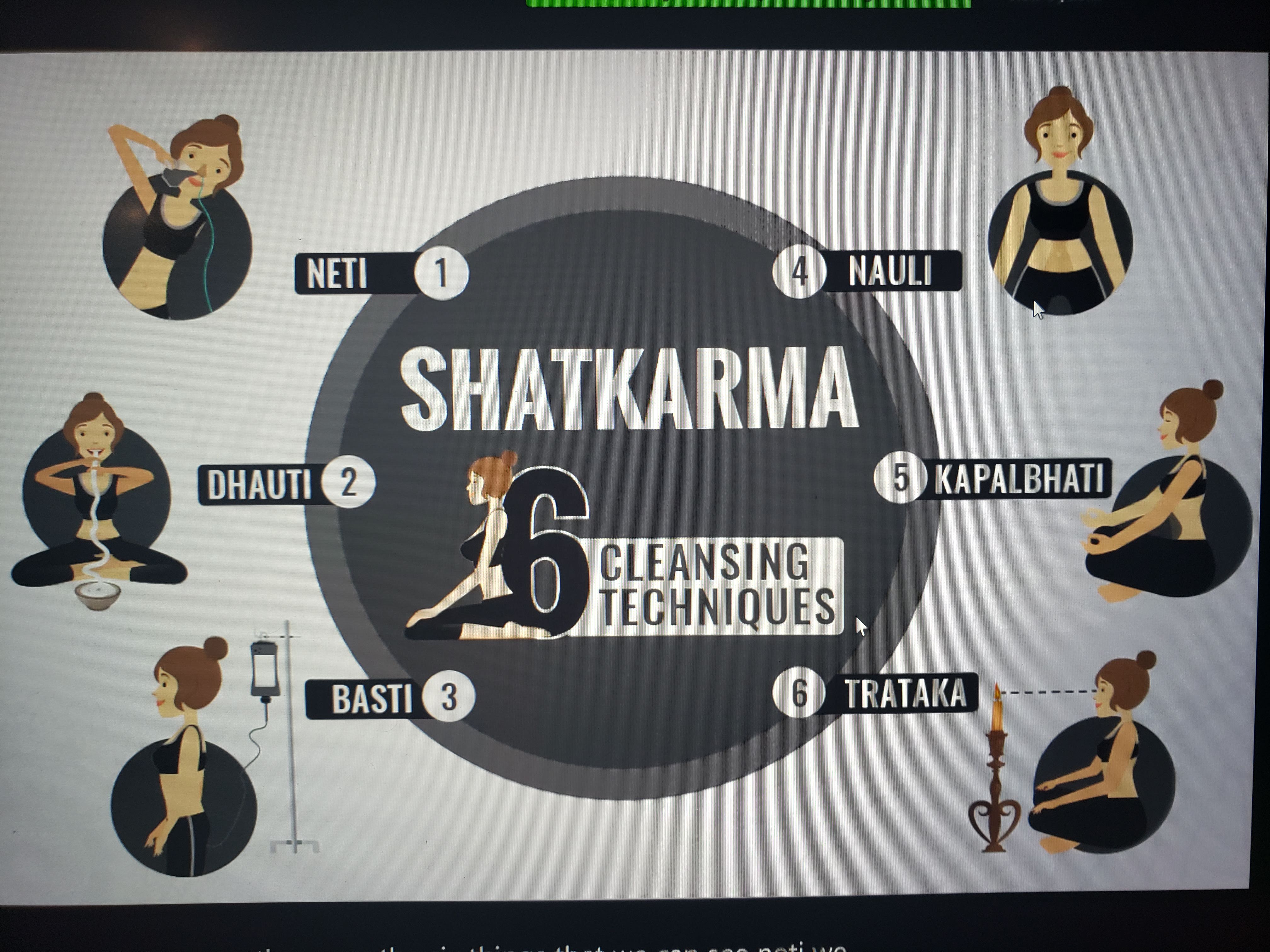
Why Kriyas are included in Yoga: Kriyas are violent/fast but still used in Yoga for
- Detoxication
- voluntary mastery of basic reflexes (Neti--mastery over sneezing reflex, Dhauti--vomitting reflex, Trataka- blinking reflex)
- After kriya, there is deeper relaxation
- Increase in blood flow to internal organs with Agnisara and Nauli
Trataka (Eye Exercises)
Trataka is fixing the mind by gazing steadily on to an object (usually a candle) without winking. For this practice relaxation of the eyes is important. This practice activates the tear glands and there by purifies the visual system. It improves the eyesight and leads to good concentration and will power.
Preparation:
- Candle, Candle Stand, Matchbox (lighter)
- Keep the candle at eye level (Do not light up in advance)
- Clean eyes with cold water, 10 minutes prior to session
- Sit in front of the candle stand, 1.5 to 2 meters away, or make a circle around it in case of group practice.
- Make the room dark. Turn off other lights in the house to make it as dark as possible.
- Keep the mobile/laptop away, so, no other light, other than a candle is there in the room. Video or audio instructions may be used.
- Trataka is a kriya, that involves, focusing and defocusing, so, participants focused attention and concentration is a must.
Safety measures:
Follow the safety rules for fire in the house.
Benefits:
Practice of Trataka purifies the eyes, strengthens the eye muscles, and improves vision and memory. It helps with sleep difficulties, strengthens the ability to concentrate and is therefore recommended for school going children also. Regular practice of trataka strengthens willpower, increases visualization power, and develops intuition.
Limitation:
This exercise is not suitable for people with psychological problems. Those who have a tendency towards Schizophrenia or hallucinations should not practice Trataka.
Suddhis are of-- Deh, Nadi, Manas, Buddhi
Deh Suddhi is by Dhauti, Basti, Neti, Nauli, Tratak, Kapalbhati, and yoga
Nadi Suddhi is by Pranayam and yog
Manas and Buddhi Suddhi is by Jaap, Mantr, Bhajan, Kirtan, Jnan
Meditation: Om Meditation and Cyclic Meditation
Cyclic Meditation Mantr:
Laye sambodhayet cittam viksiptam samayet punah Sakasayam vijaniyat samapraptam na calayet
When the mind gets to a state of drowsiness, stimulate and awaken it; as it starts speeding up and distractions set in, calm it down. Do this again and again(Mandukya Karika 3-4).
Trikorn Suddhi is cleaning of thoughts, using humble words, and doing action for larger good. It is aligment of thought, words, and actions.
Bharti Raizada

Question - The 3 layers of muscles located between each of the ribs that assist with respiration are:
The external, internal, and innermost intercostal muscles
Question: The muscle that could be considered the physical aspect of uddiyana bandha is:
The iliopsoas
Question: The energetic purpose of mula bandha is:
To prevent the downward escape of energy
Question: The muscles in the pelvic floor that could be considered the physical aspect of mula bandha are:
The pubococcygeal muscles
Question: Secondary respiratory muscles that assist on the inhale include:
Sternocleidomastoids, scalenes, intercostals
Question: The type of respiration that is not under your direct conscious control is:
Involuntary respiration
Question: On an exhalation, the diaphragm relaxes and ascends.
True
Question: How many pairs of ribs make up the rib cage?
Twelve
Question: Gas exchange happens at the:
Alveoli
Question: The left lung is different from the right lung because it has:
Two lobes and a cardiac notch
Question: The primary muscle of respiration is the:
Diaphragm
Pranayam:
It was given importance at the 4th level of ashtang yoga.
After yam, niyam, and asan the inhalation-exhalation practice is pranayam. Pranayam practices directly affect the mind and lifespan. Less breahing means less movement of chit. Rapid breathing leads to rapid movement of chit.
Padmasan or Siddasan are good. Sitting straight- diaphragm is downwards- abdomen is compressed. It is important to keep the vertebral column straight. In this position, prana can enter Susumana easily.
Mudra-index and middle finger are bent, other 2 fingers and thumb are straight. Elbow downwards or forearm parallel to ground.Thumb used for rt nostril and little/ring finger for left nostril.
Close nostrils at the level of nasal bones, not at the tip of nostril.
Wrong pranayam practices may lead to some disorders, diseases, or harm.
Kumbhak increases the CO2 tolerance of cells. Kumbhak does not increase the oxygenation of cells.
There are Asth Kumbhaks- eight types of pramayam.
-
Anulom Vilom Pranayam, Nadi Shodhan Pranayam- cleans the nadis. 72000 nadis. All these open in ten big nadis- 2 eyes, 2 nostrils, 2 ears, mouth, anus, genitals, top of head(sahastra chakra or dasham dwar). Shahastra chakra is open until six months. Most important are three nadis- Ida(left nostril), Pingala(rt nostril), and Susumna.
Anulom vilom- first inhalation is from left nostril. There is no kumbhak in anulom vilom. When anulom vilom is practiced with kumbhak then it is called Nadi shodhan pranayam.
Initially, practice inhalation exhalation for equal time. Then, increase the exhalation duration until is it double the inhalation time, 1:2 ratio. Then, practice kumbhak after poorak- initially equal to inhalation time and then slowly increase to double the inhalation time. 1:1:2 to 1:2:2 to 1:3:2 to 1:4:2. During kumbhak, close both nostrils.
During kumbhak, apply Jalandhar bandh ( chin to sternal notch). In advanced stages, all bandhas can be applied. First apply Moolbandha(anal and perineal area contraction), then apply Jalandhar bandha and then Uddiyan bandha.
First inhale from left nostril with mool bandha. Then do anter kumbhak and then apply Jalandhar bandh and then uddiyan bandha during kumbhak. While finishing kumbhak, release Uddiyan bandha first and then Jalandhar bandha. Then exhale from the right nostril. Mool bandha is still on. Now inhale from right nostril- mool bandha is still on. During Bahay kumbhak apply jalandhar bandha first and then Uddiyam bandha. At the end of kumbhak, release uddiyan bandha first and then jalandhar bandha. Now exhale from left nostril. After finishing this cycle, release mool bandha. In advanced stages, keep applying moolbandha(without release) for the whole duration of pranayam (for many cycles).
By mool bandha, anal and sex openings are closed. By jalandhar bandha, eyes, nostrils, ears, mouth doors are closed. During Uddiyan(move upward/fly) bandha, prana can enter the susumana nadi and move upwards.
This practice strenthens the automonic nervous system, gives calmness and coolness. There is no contraindication for this practice.
Aim should be on the duration of breath, not on producing sound.
When yogi exhales fully, most Co2 goes out and during the inhalation, lungs get filled with oxygen. Air moves from area of high pressure to low pressure. So, after complete exhalation, there is full oxygenation. -
Surya bhedan pranayam: All inhalations are from right nostril, and all exhalations are from left nostril. Can apply jalandhar bandh during kumbhak. Rechak is double the time of poorak. This pranayam generated heat. Useful in low weight, low metabolic rate. This increases acidity and pitta.
Ujjayi pranayam: It gives victory over many diseases. Inhale and exhale from both nostrils, but contract the glottis and produce a hissing sound. It makes air warmer. It stimulates thyroid gland and therefore it is useful in thyroid disorders. Helpful in decreasing mucus in oropharynx. It increases lung capacity and oxygenation. It gives calmness and coolness to head. It can be practiced in sitting, standing, or walking positions. Avoid rhis practice in case of infections of throat. In later stages, inhale from both nostrils, apply kumbhak, and then exhale from left nostril. Throughout, contract the glottis and produce hissing sound during inhalation and exhalation. -
Bhastrika Pranayam: Modern way- Active inhalation and active exhalation. Ancient Bhastrika is a combination of active kapalbhati and suryabhedan. Start with atleast 20 strokes of kapalbhati. At the last stroke, elongate the exhalation. Immediately inhale from right nostril, apply kumbhak, and then exhale from the left nostril. Now, inhale from both nostrils in preparation of next round of kapalbhati. Slowly increase the number of strokes of kapalbhati. Kapalbhati and surya bhedhan can be done with ujjayi pranayam. This generates tremendous heat in body. Avoid this in heart diseases, acidity, etc. Very good pranayam for kapha dosha. Good for joint pains also and body temperature increases and it keeps joints warm.
-
Shitkari Pranayam: cooling pranayam. Inhalation from mouth and exhalation from nostrils. Teeth are over each other, tip of tongue is on the back side of teeth. Inhale while making Sheee sound. No sound during exhalation. Exhalation time is more than inhalation. Air gets moist and cool while coming in contact with saliva and tongue. At later stages, you can apply kumbhak and exhale from left nostril only. 1:1 or 2:2. This pranayam is good for smokers as it affects taste buds and smokers develop aversion for smoke. Good for hyperactive people and hyperacidity. Not good for kapha and vaata dosha. Not good in cold weather. Good in summers.
-
Shitali pranayam: cooling pranayam. Inhalation from mouth and exhalation from nostrils. Take front of tongue out of mouth, fold it upwards from both sides and a tube of it. Now, inhale from this tongue tube and exhale from nostrils(preferably left nostril). It comes naturally after drinking very hot drinks and eating hot, spicy foods. Avoid in Vatta and kapha dosh. Useful in Pitta dosh, hyperacidity, heart diseases, HTN, burning sensation in body.
-
Chandra bhedhan pranayam
-
Advanced pranayam: Murcha, Plavani.
- HR of frog 120-130, lives for 10-12yrs
- Hamster 34-114, 18- 36 months
- Guinea pig 42-105, 5yrs
- Sloth 6-108, 20 to 40 yrs
- 3lined squirrel 100-125, 10 to 20yrs
- Cheetah 60-150, 8 to 10yrs
- Rats 85, 12 to 18months
- Rabbits 30-60, 3-8yrs
- Pigs 32-58, 15 to 20yrs
- Cow 26-50, 15-20yrs
- Pigeon 25-30, 6yrs
- Horse 10-14, 50yrs
- Girrafe 8-15, 20yrs
- Duck 14, 5-10yrs
- Dog 18 to 34, 20yrs
- Cats 16-40, 30yrs
- Goat 12-24, 10yrs
- Tortoise 4, 200yrs
- Elephant 4-5, 50yrs
- Allegator 1, 30-50yrs
- Salmon 2.2-2.4, 2-7yrs
- Scorpion can hold breath for 6days, 3-5yrs
- Jellyfish and Hydra respiration is by diffusion and they are immortal


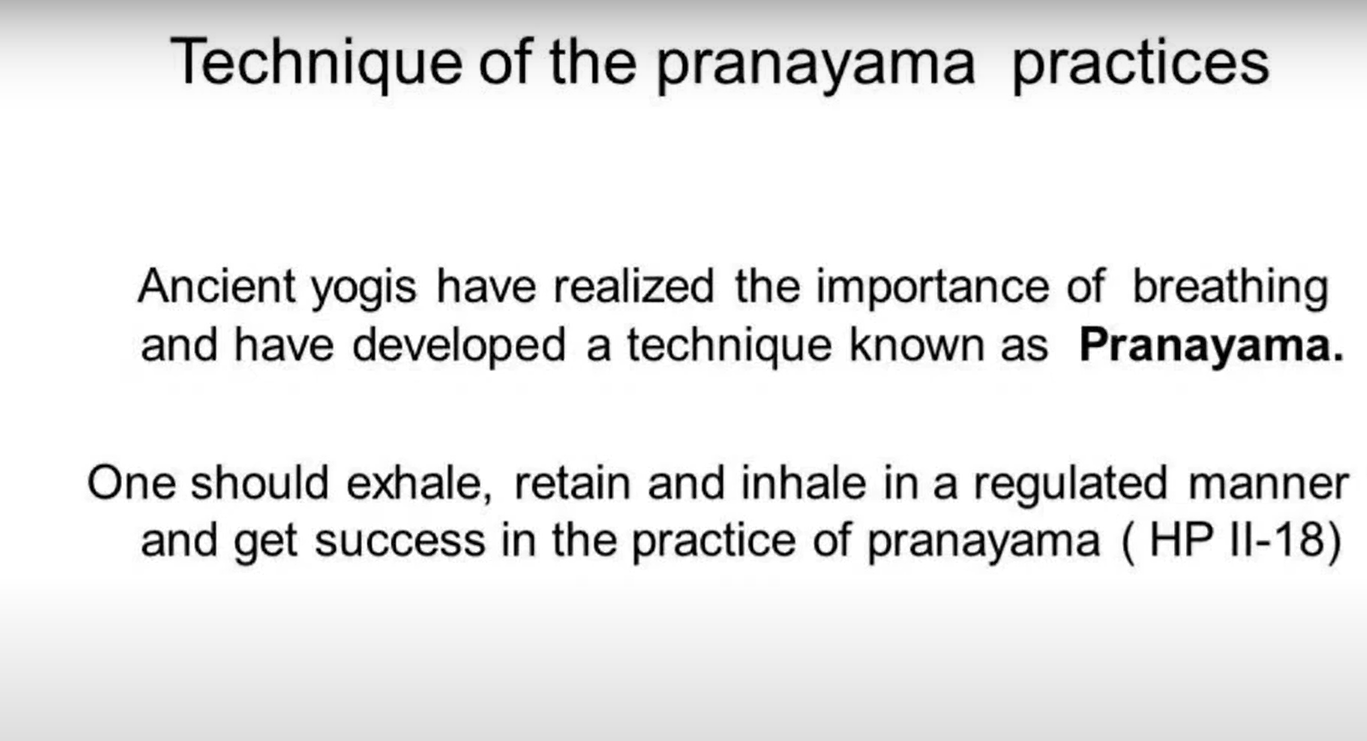
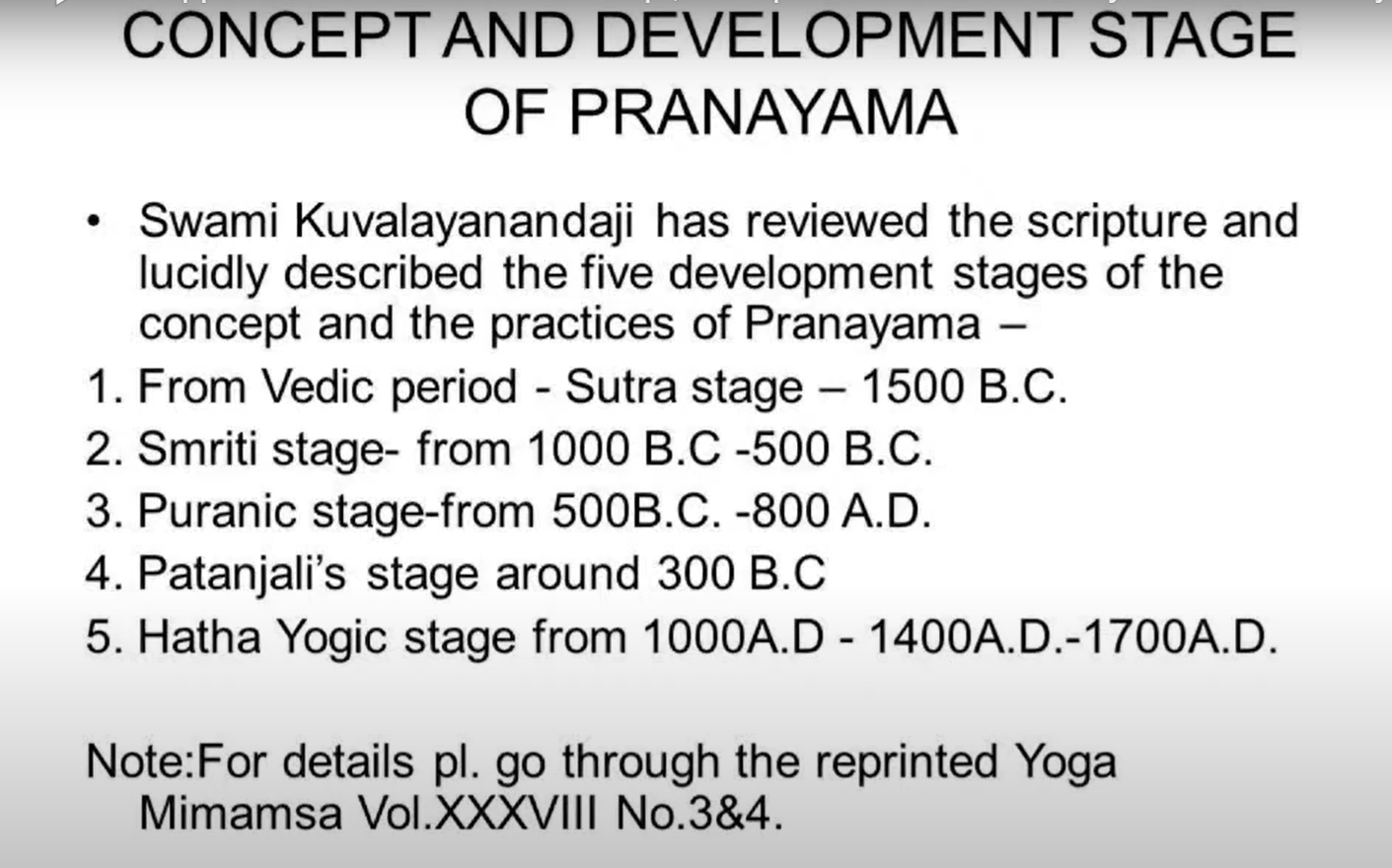
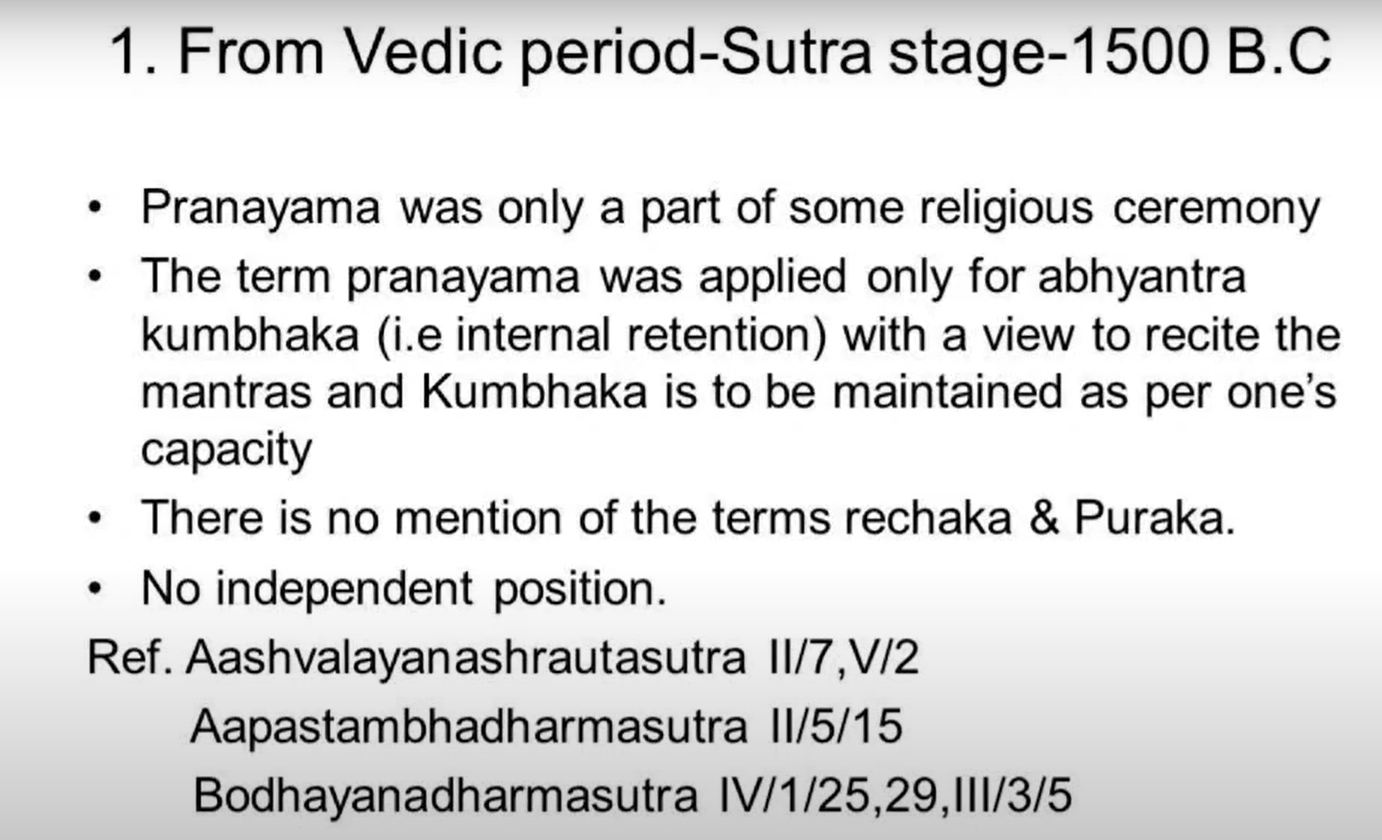
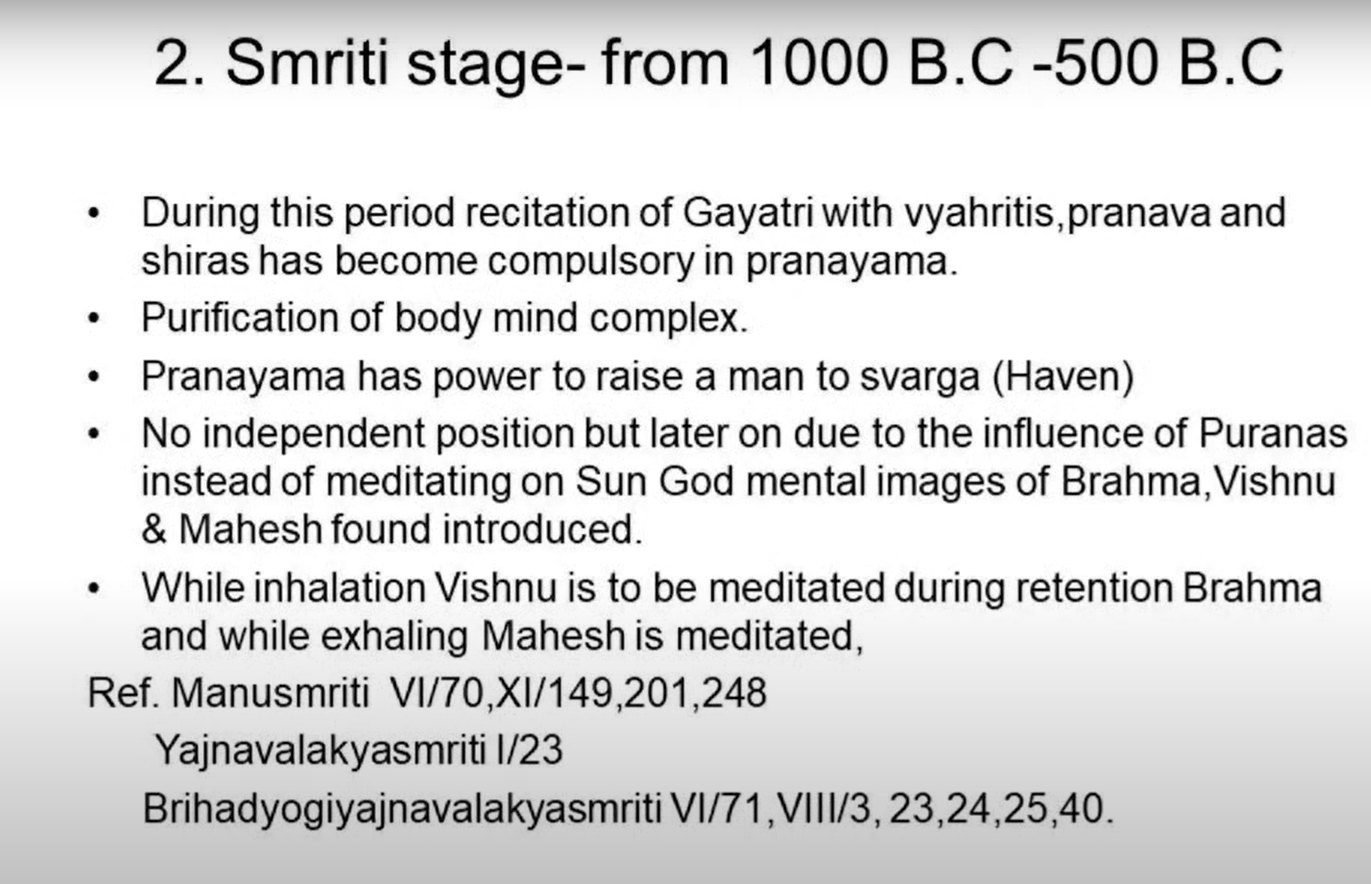
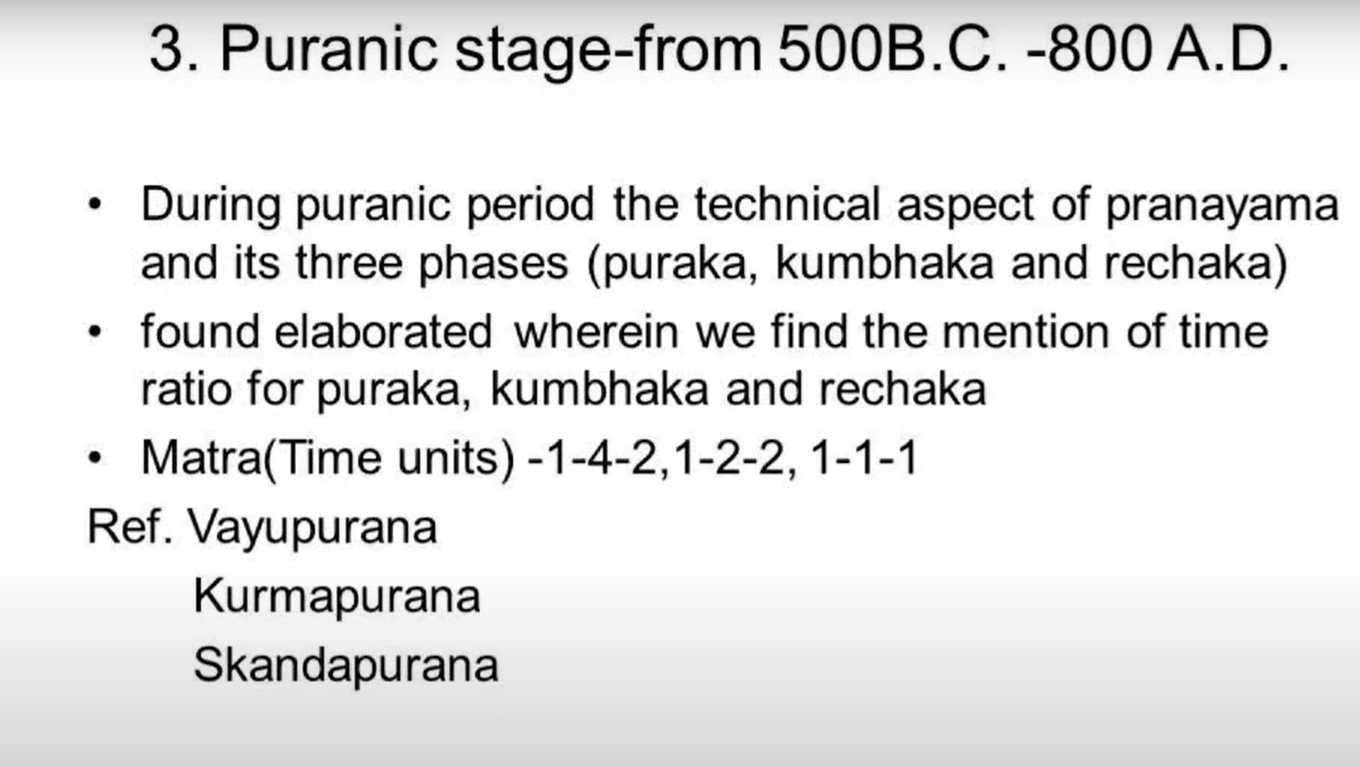
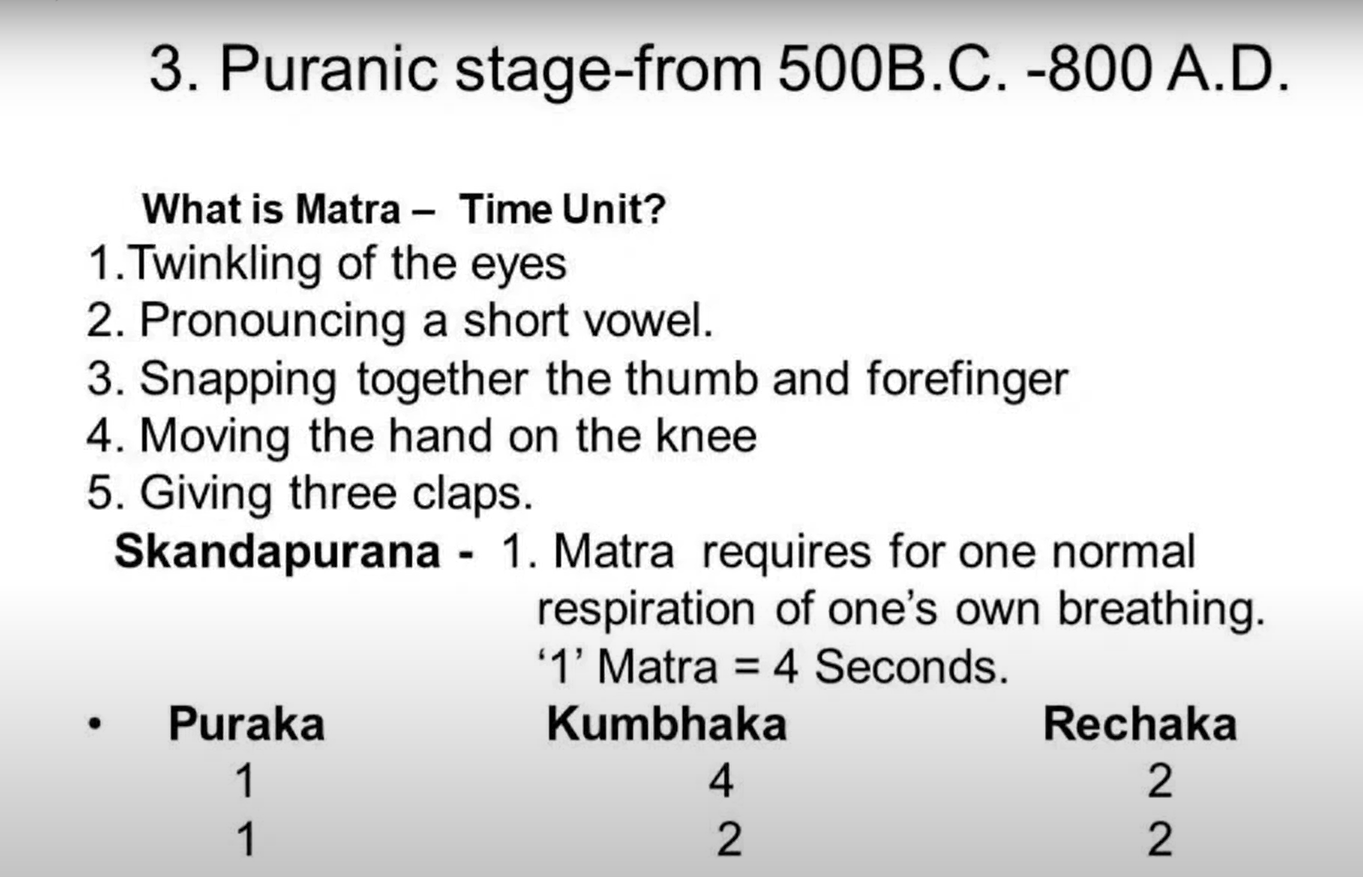

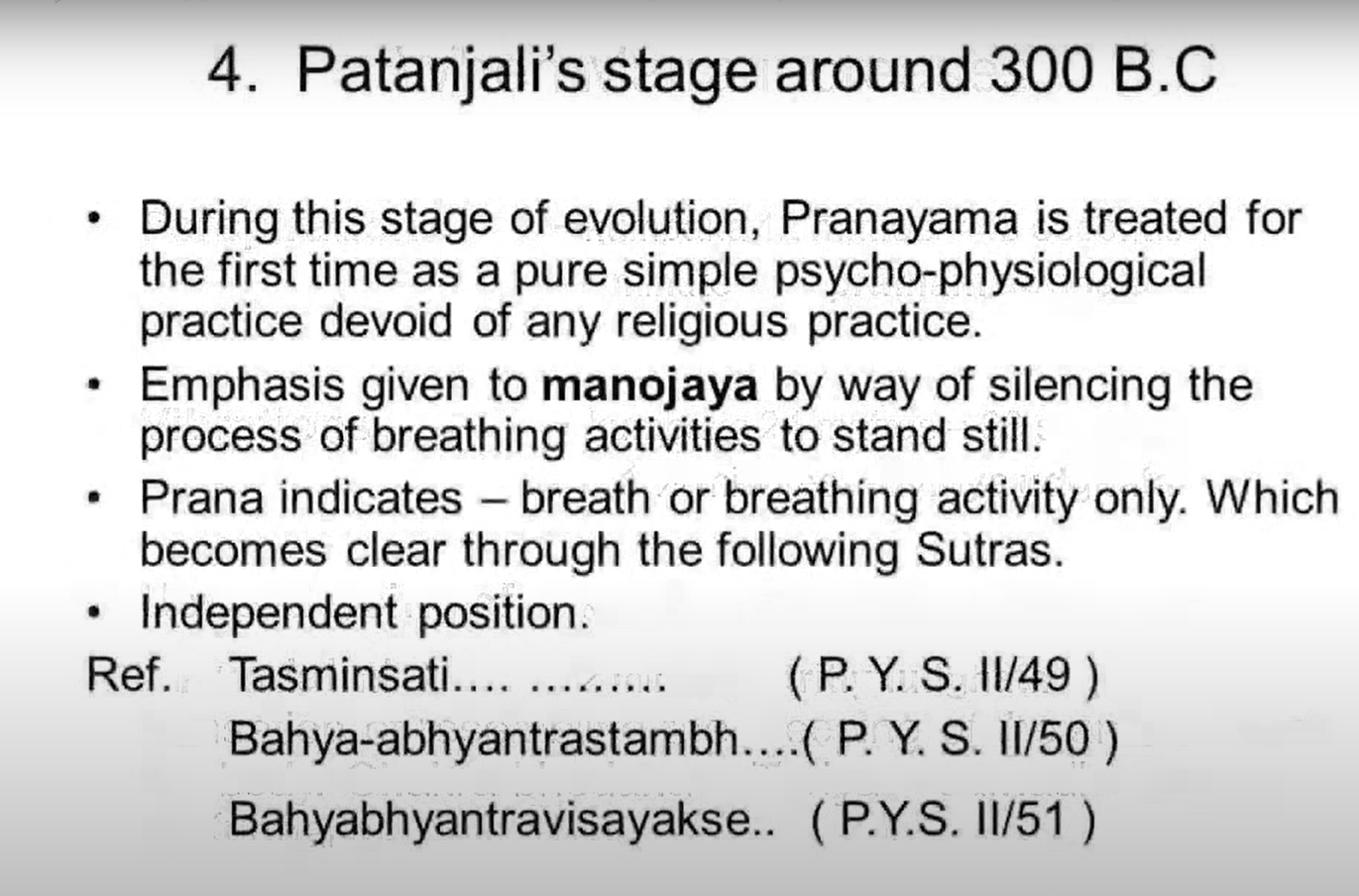

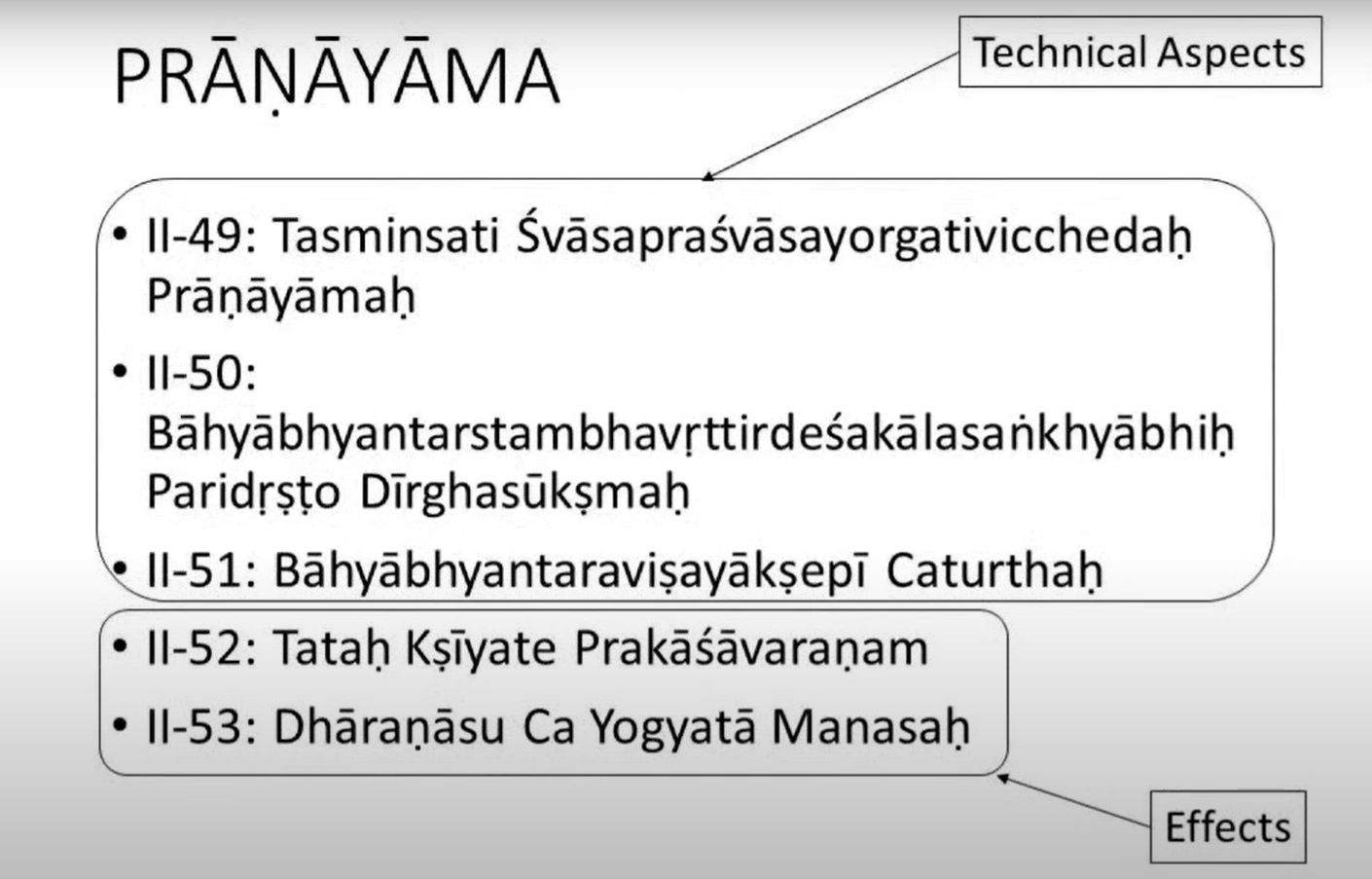
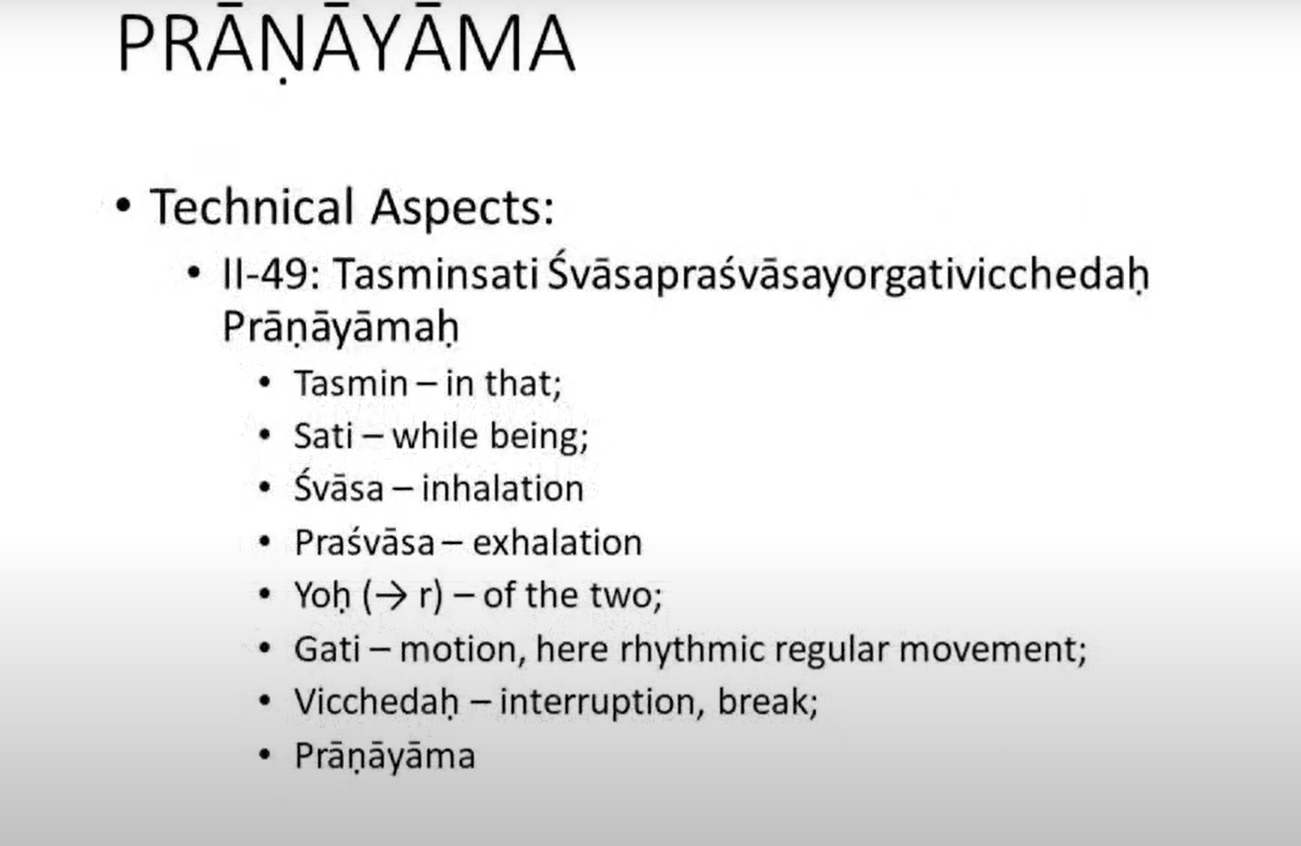
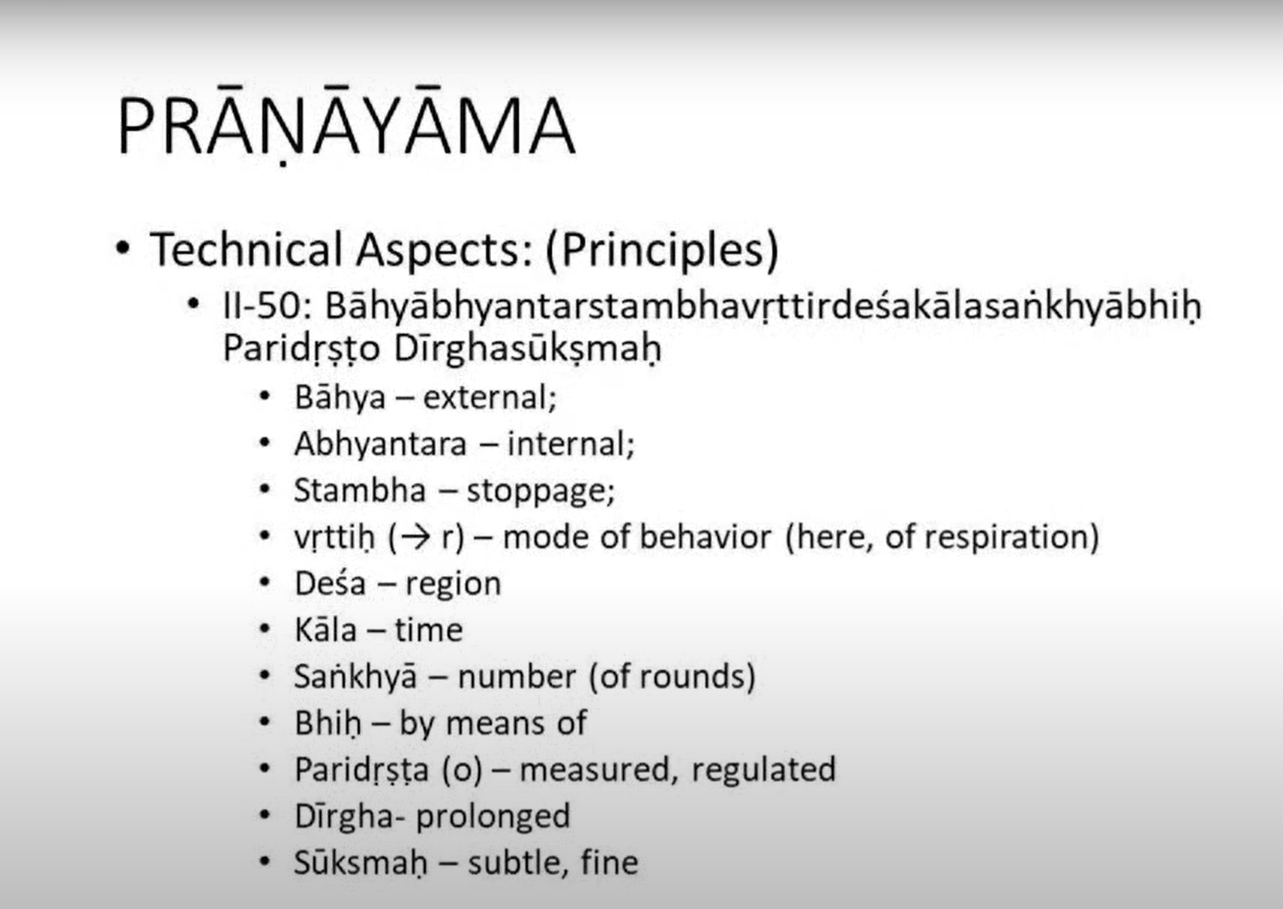
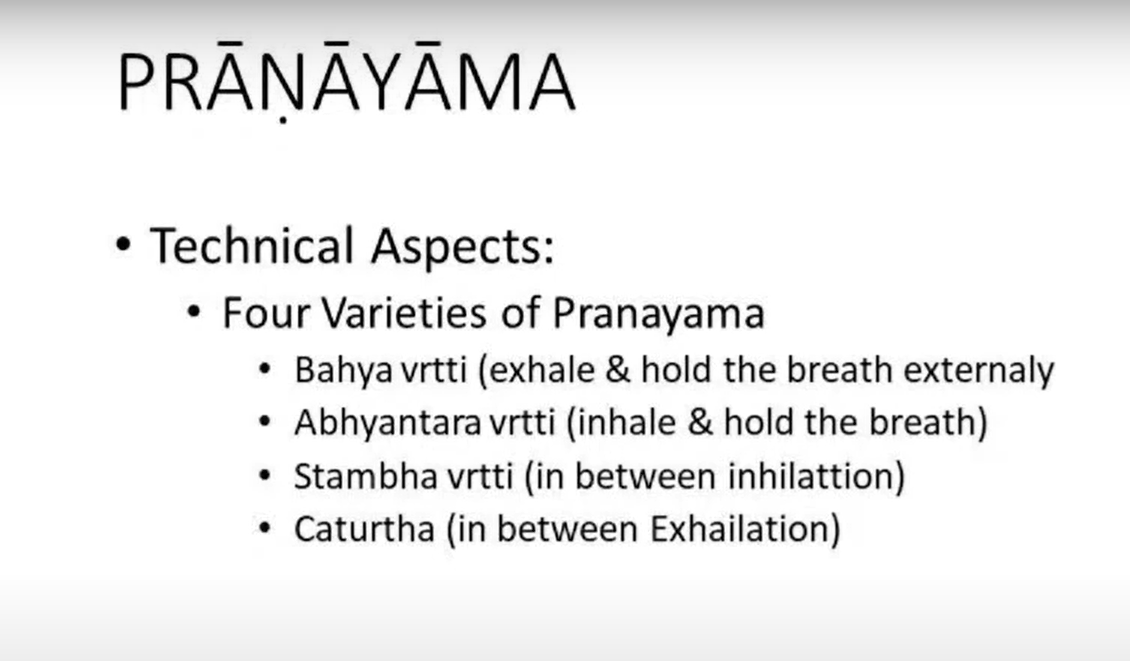
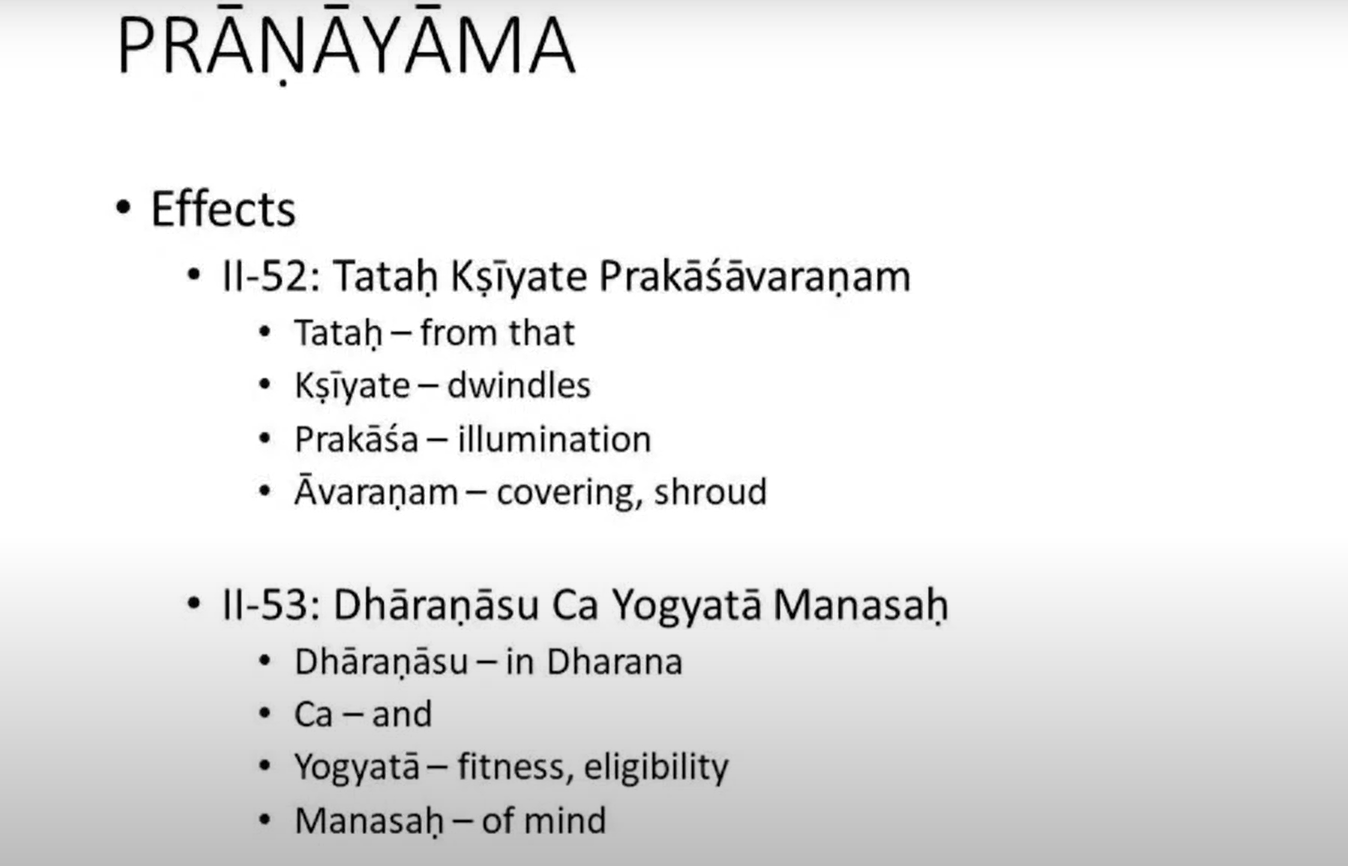

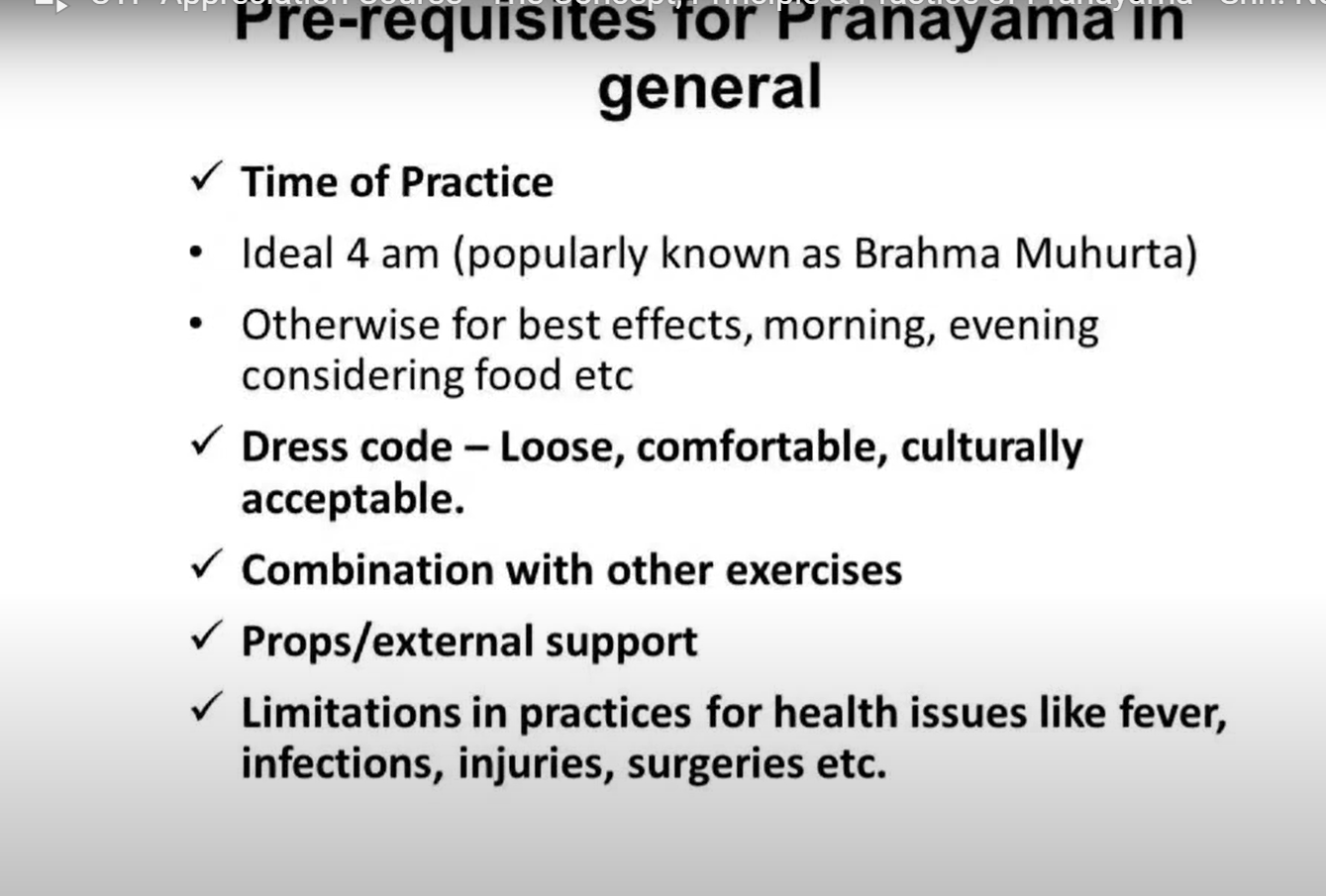
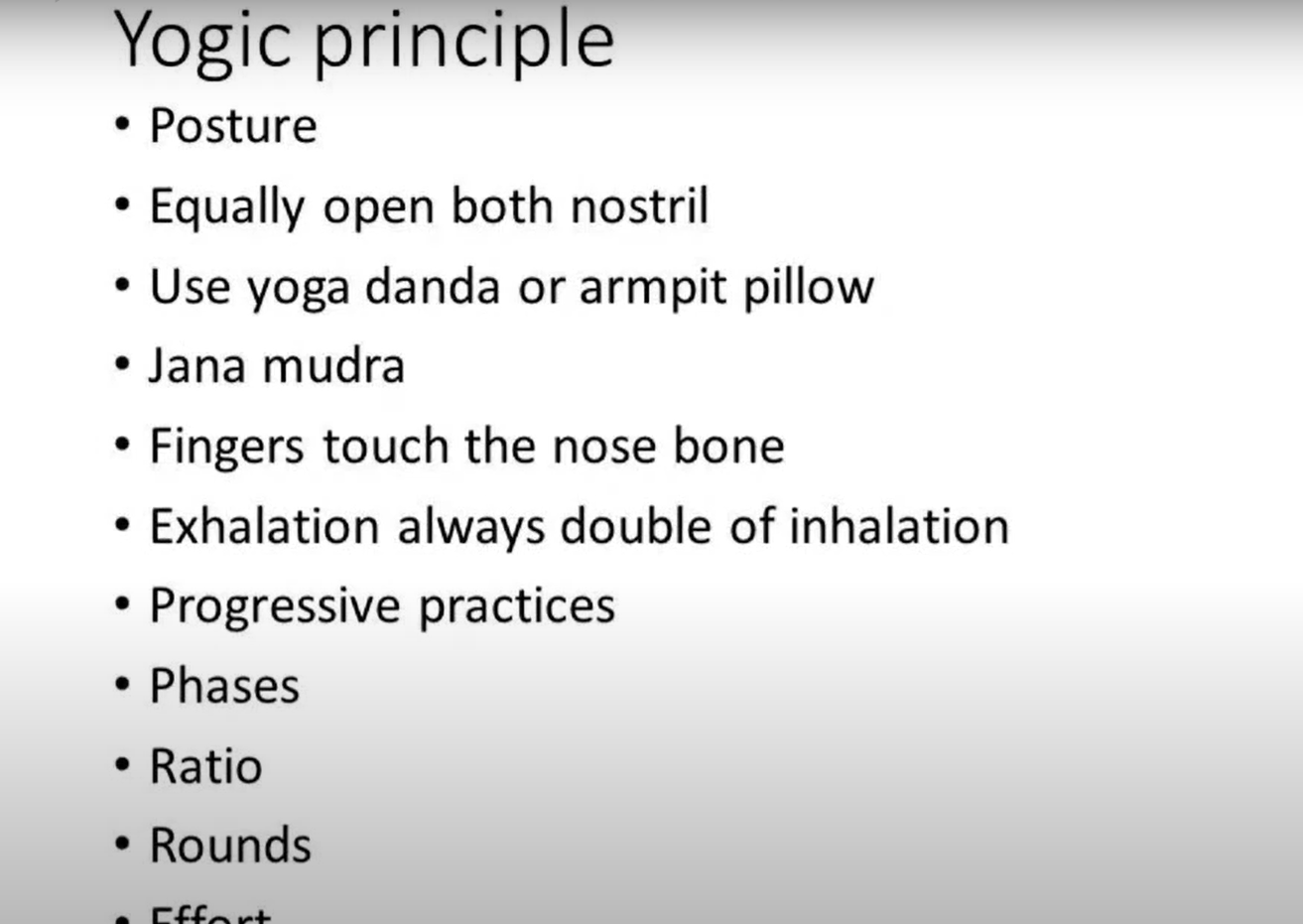
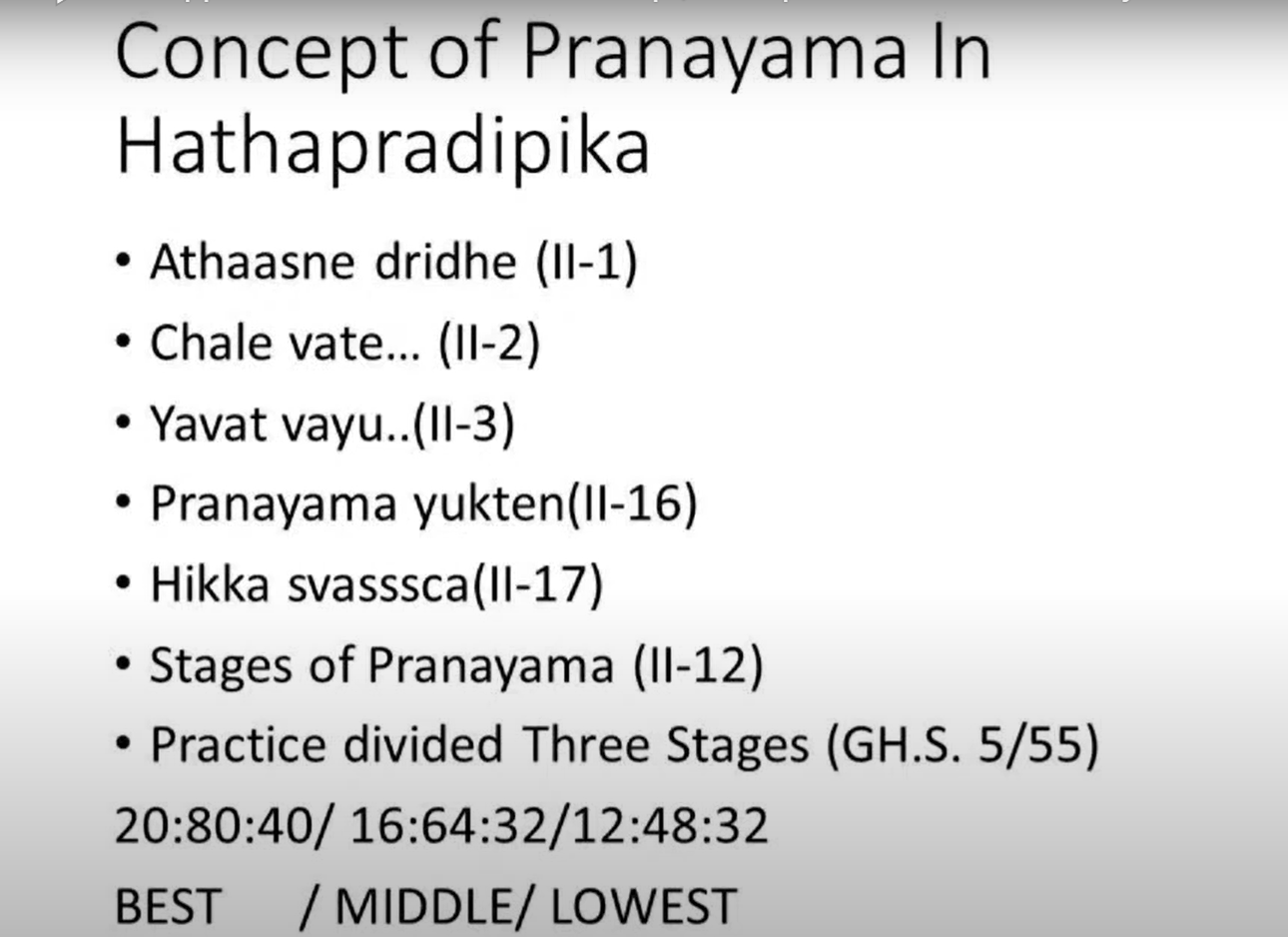
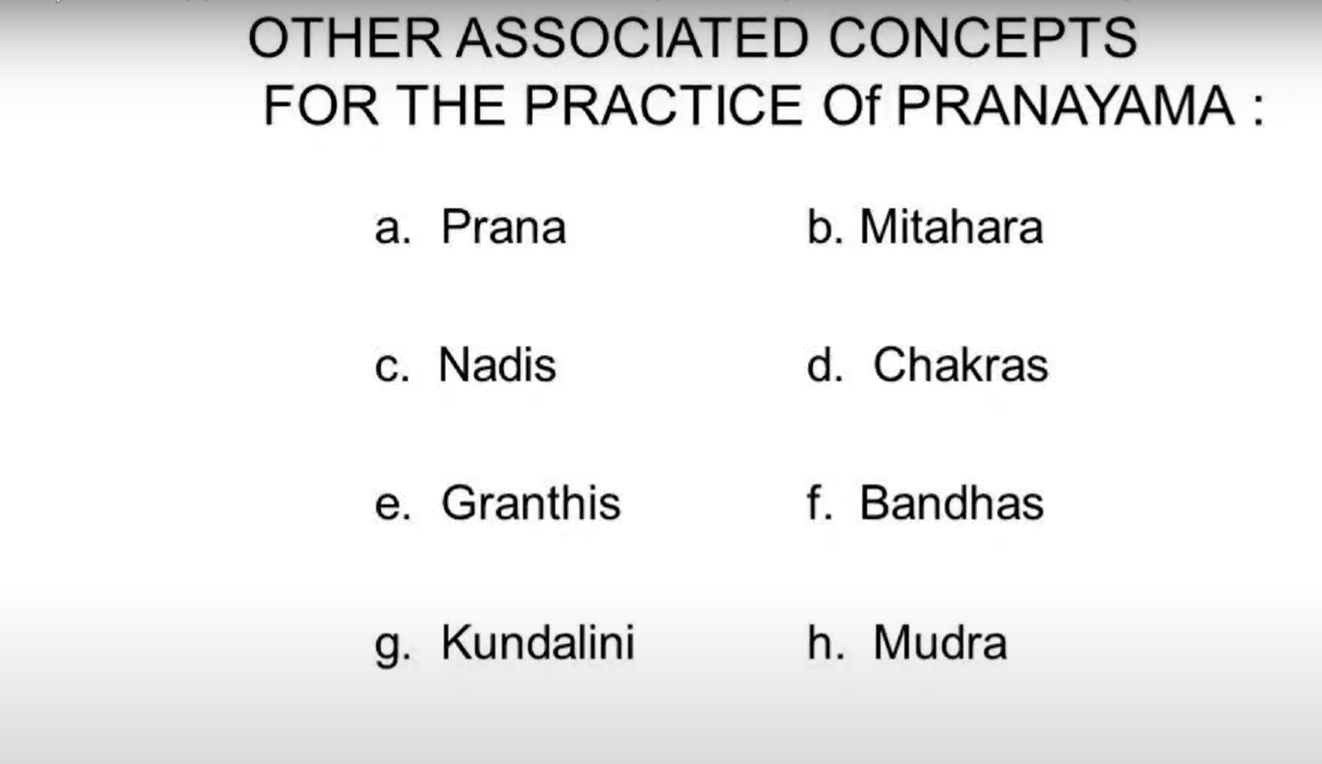
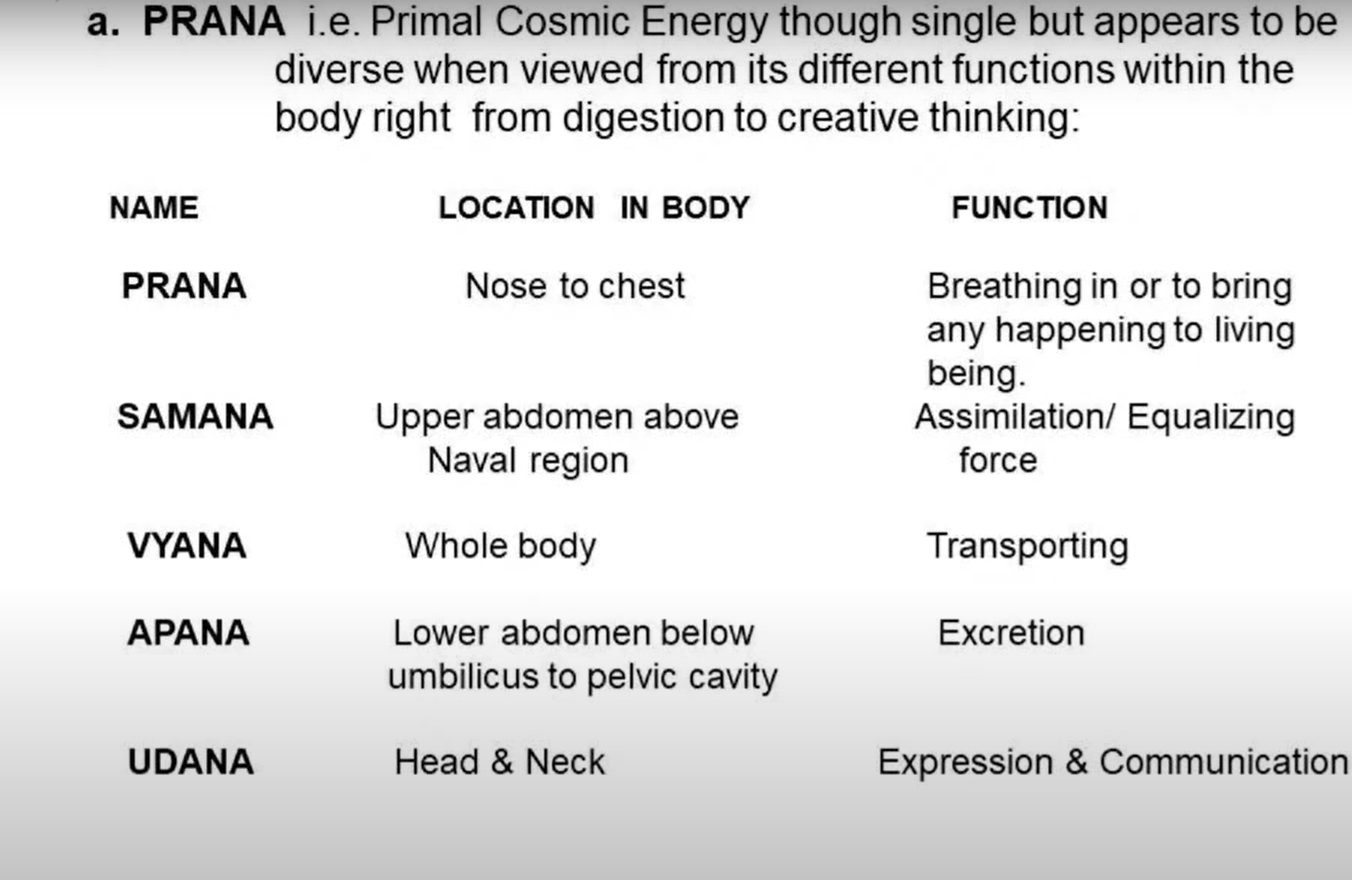
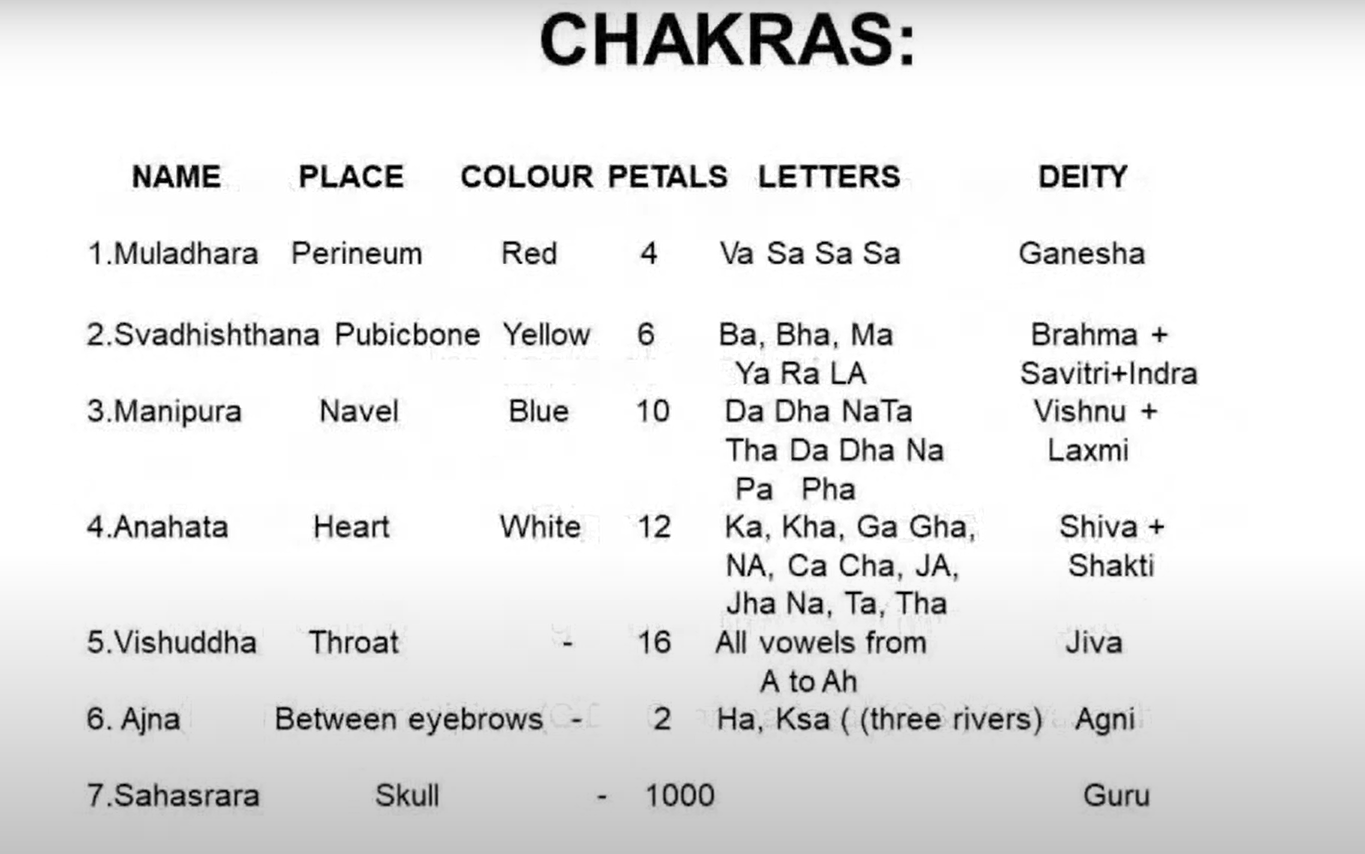

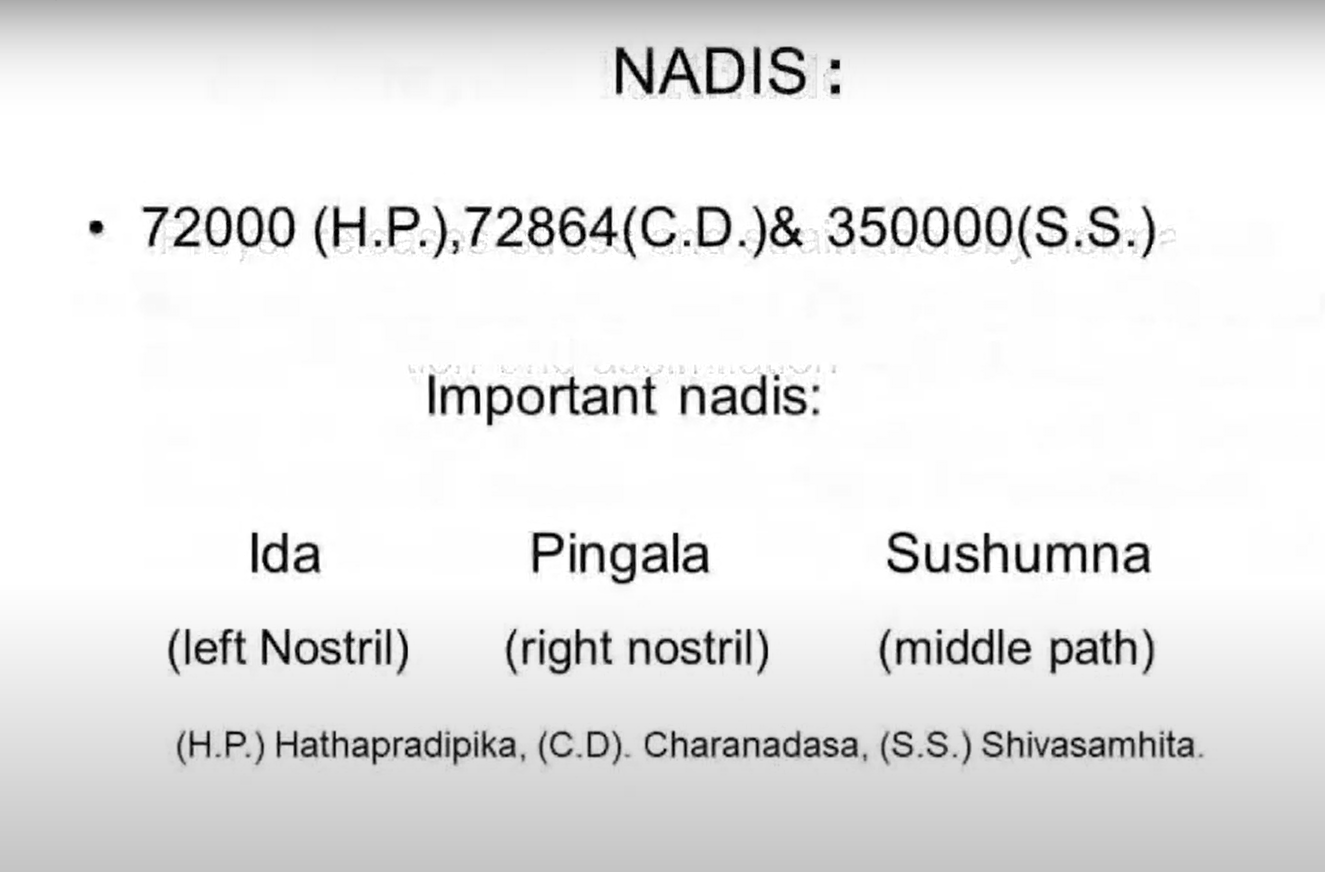
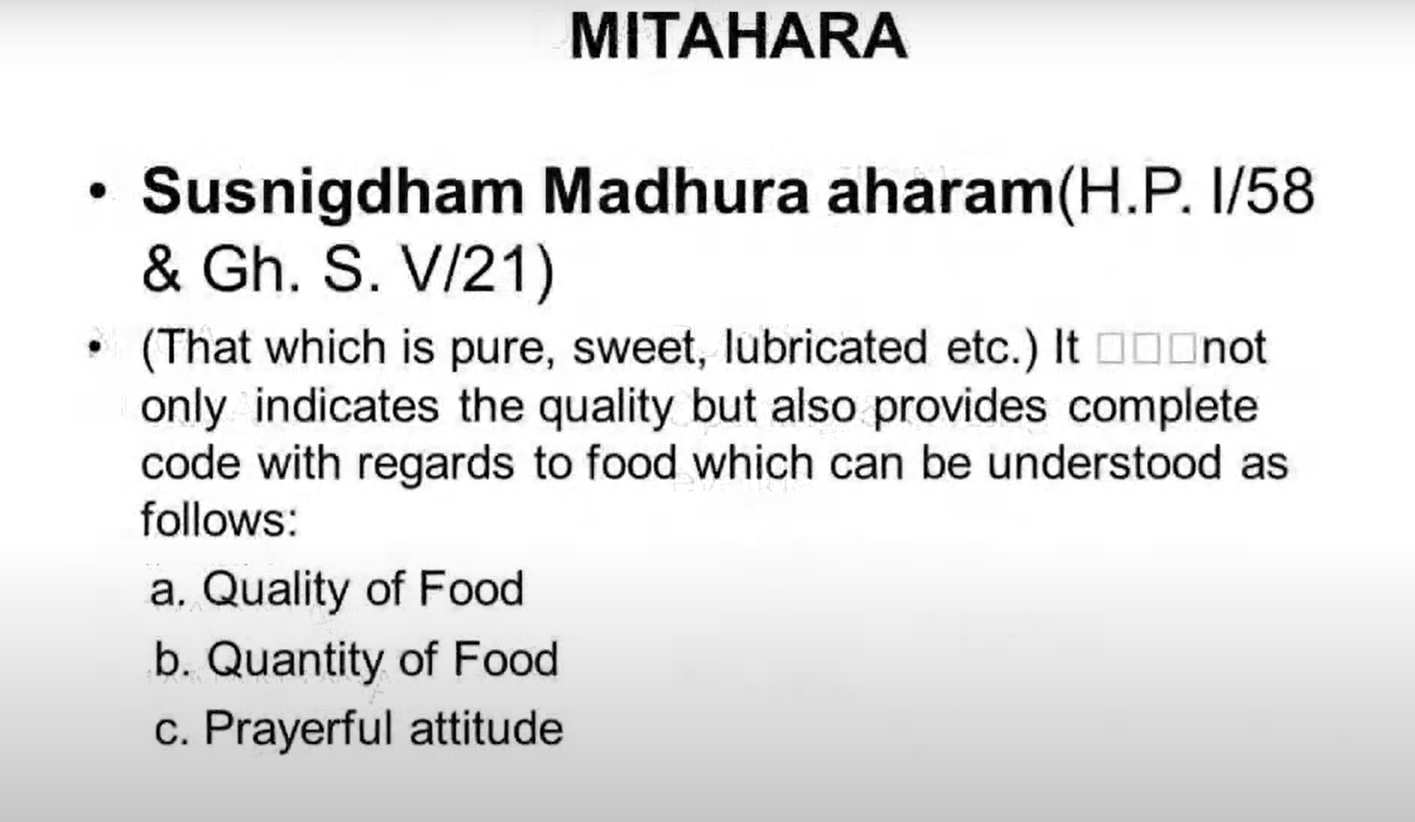

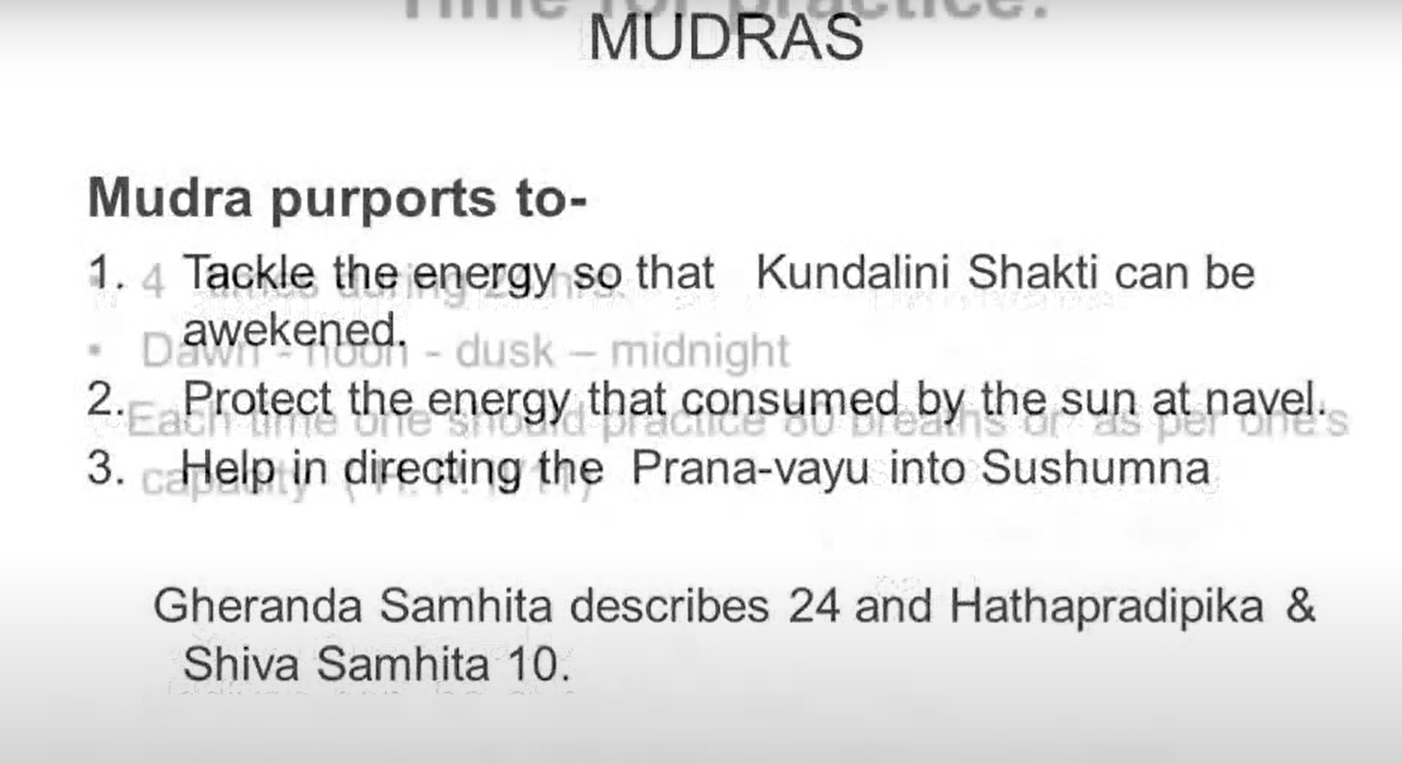

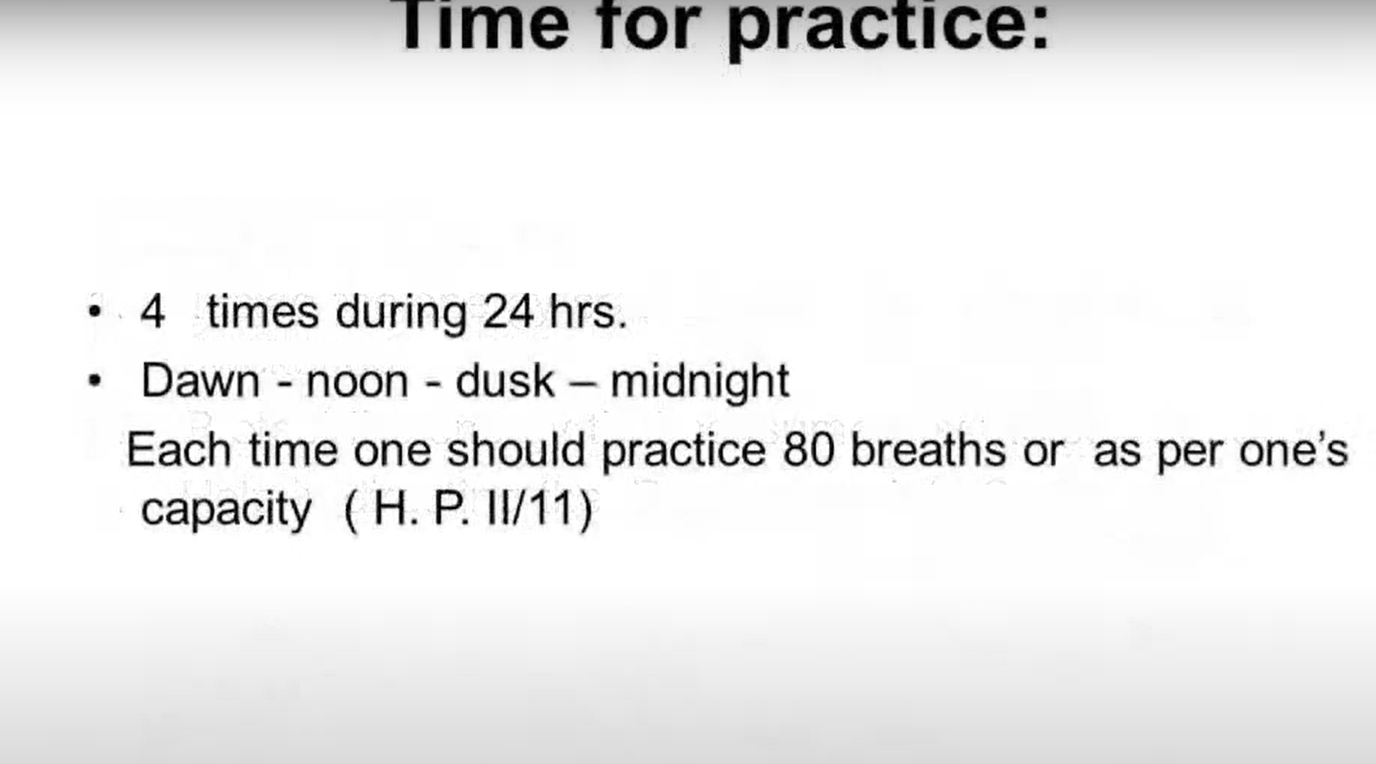
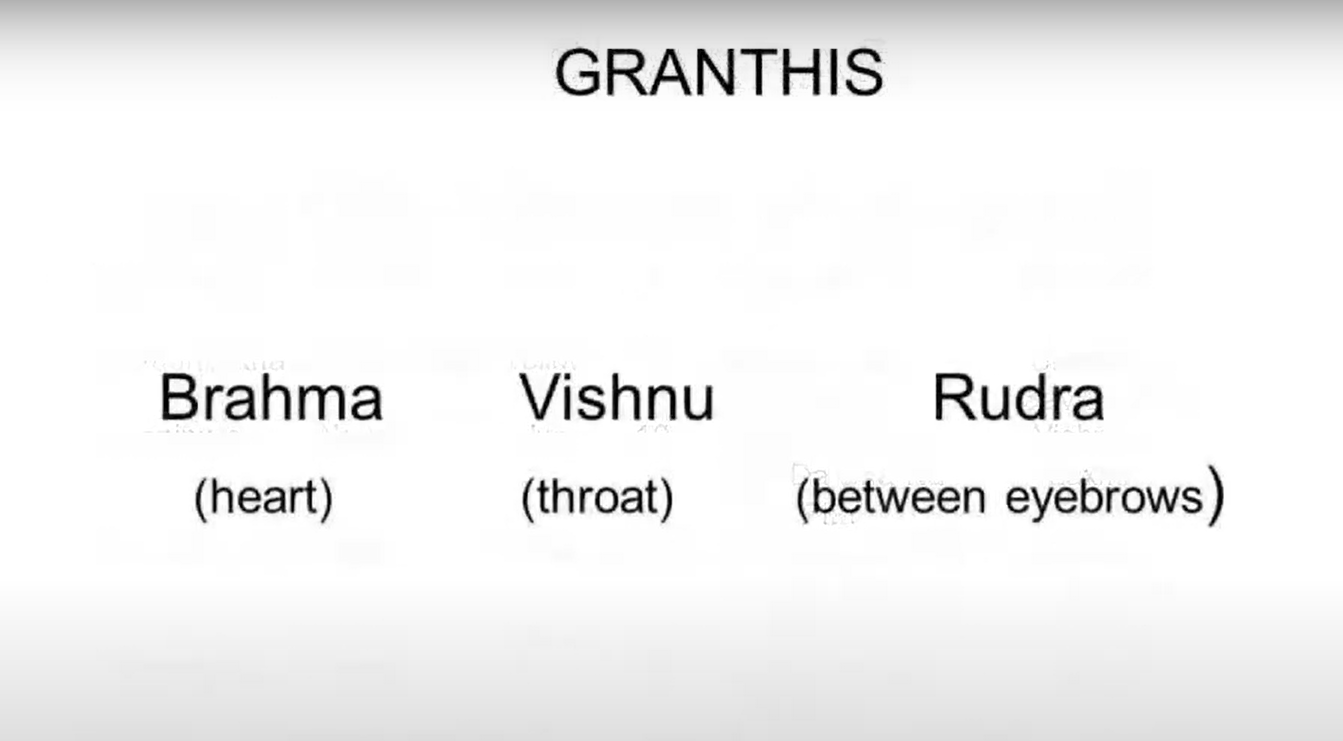
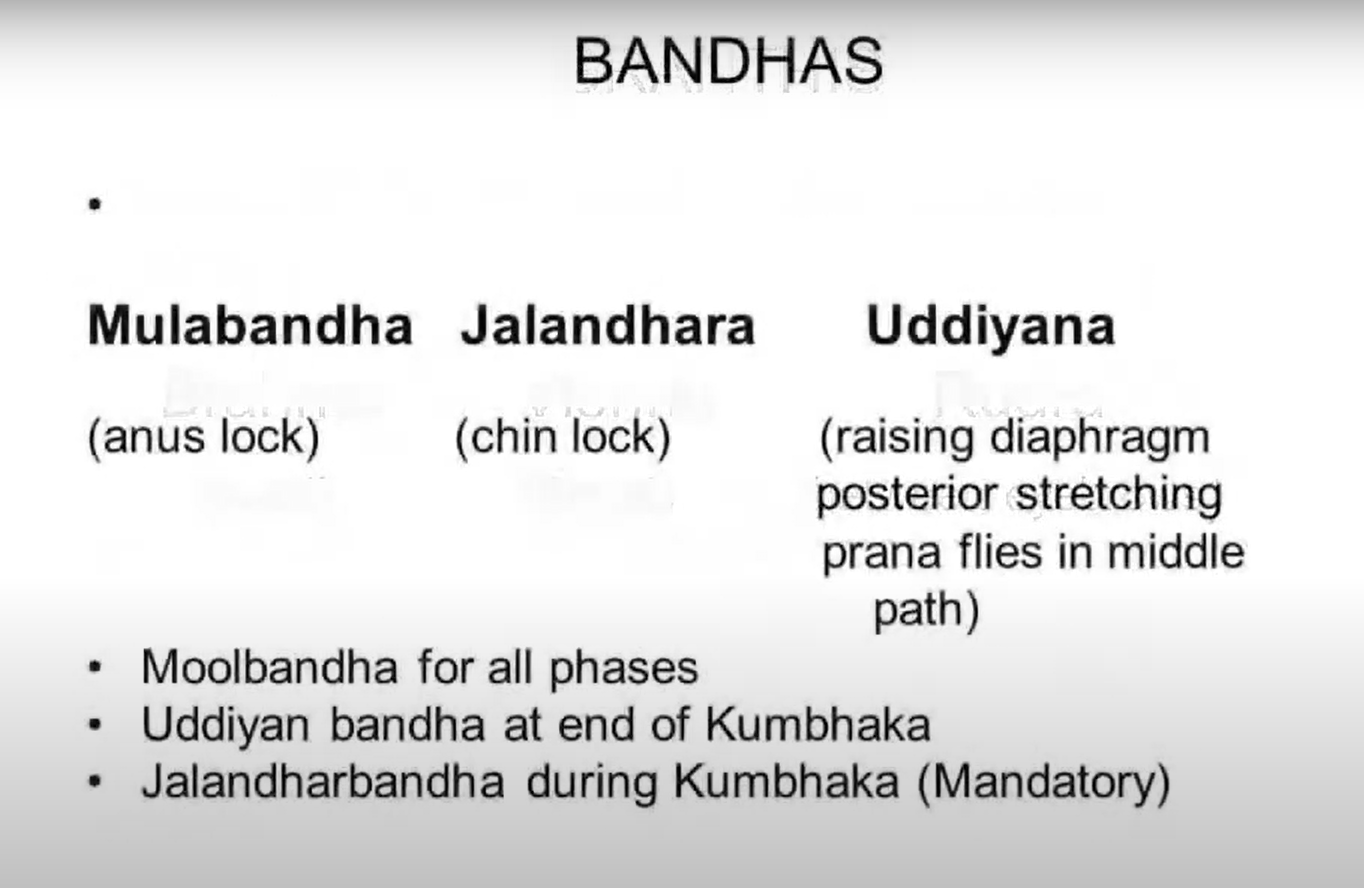
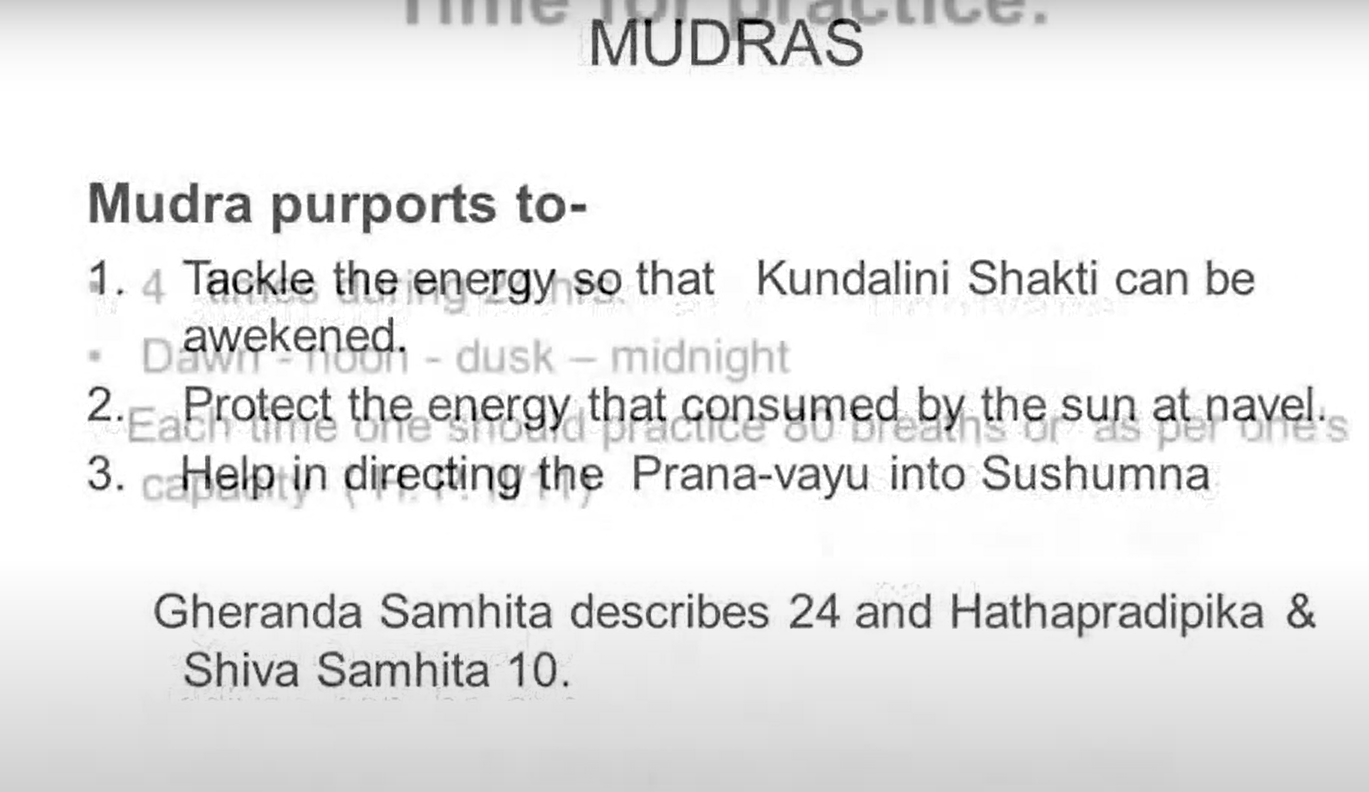
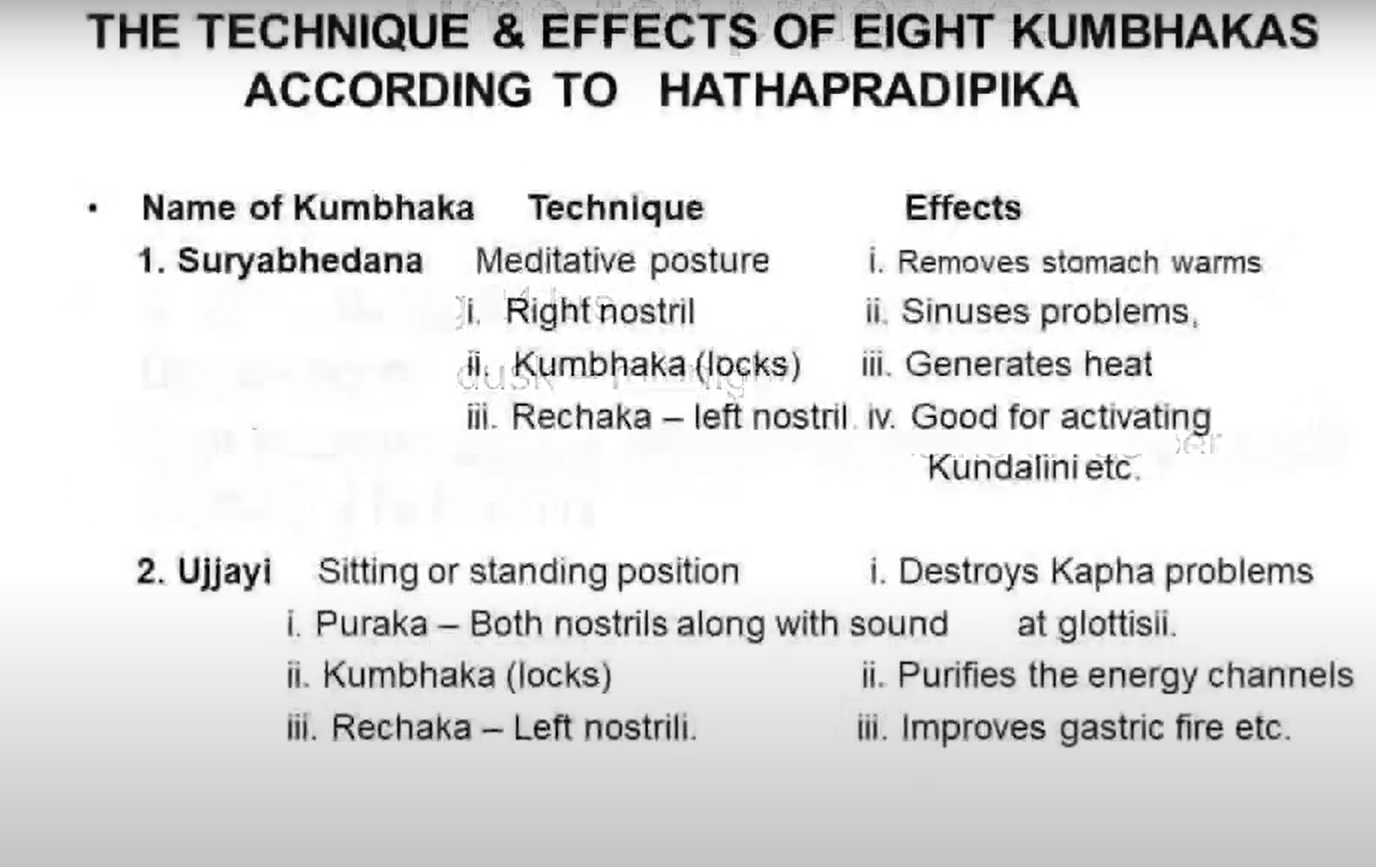
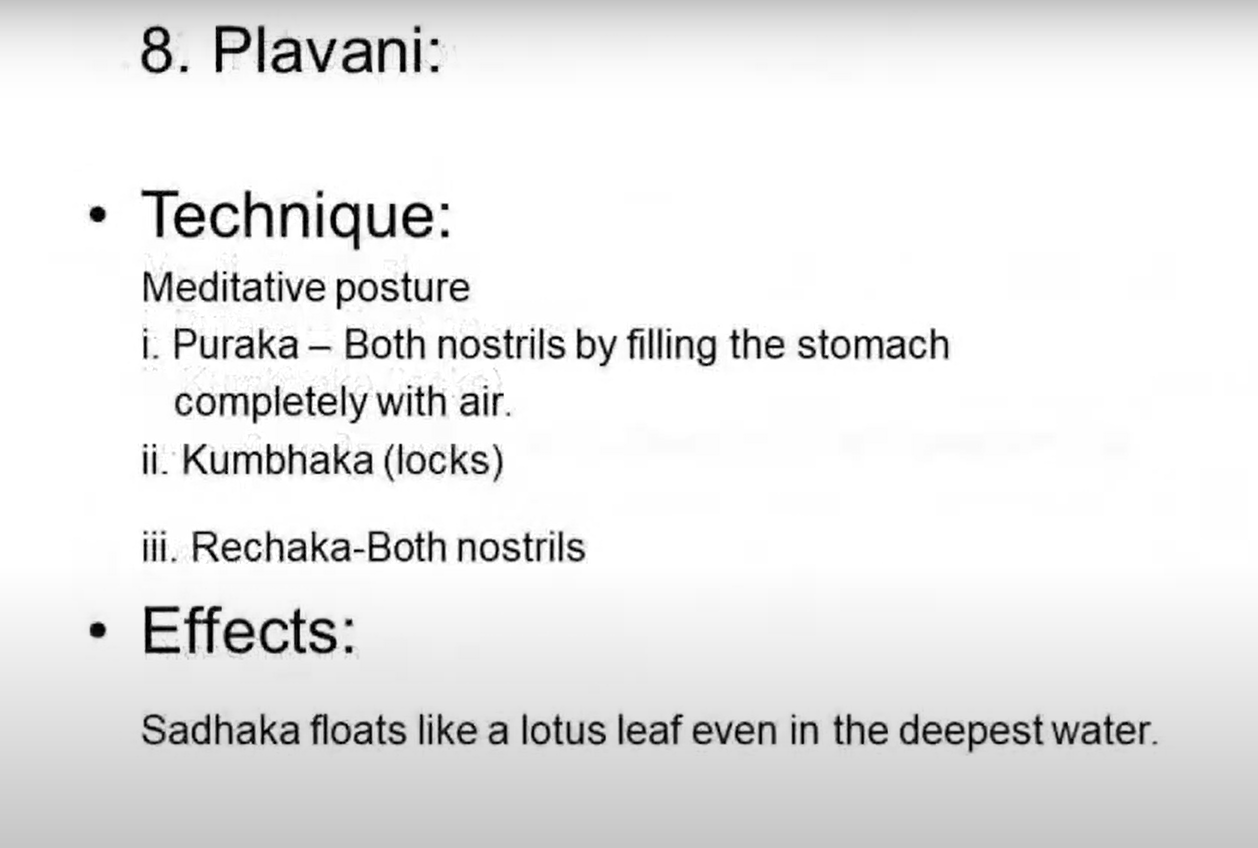
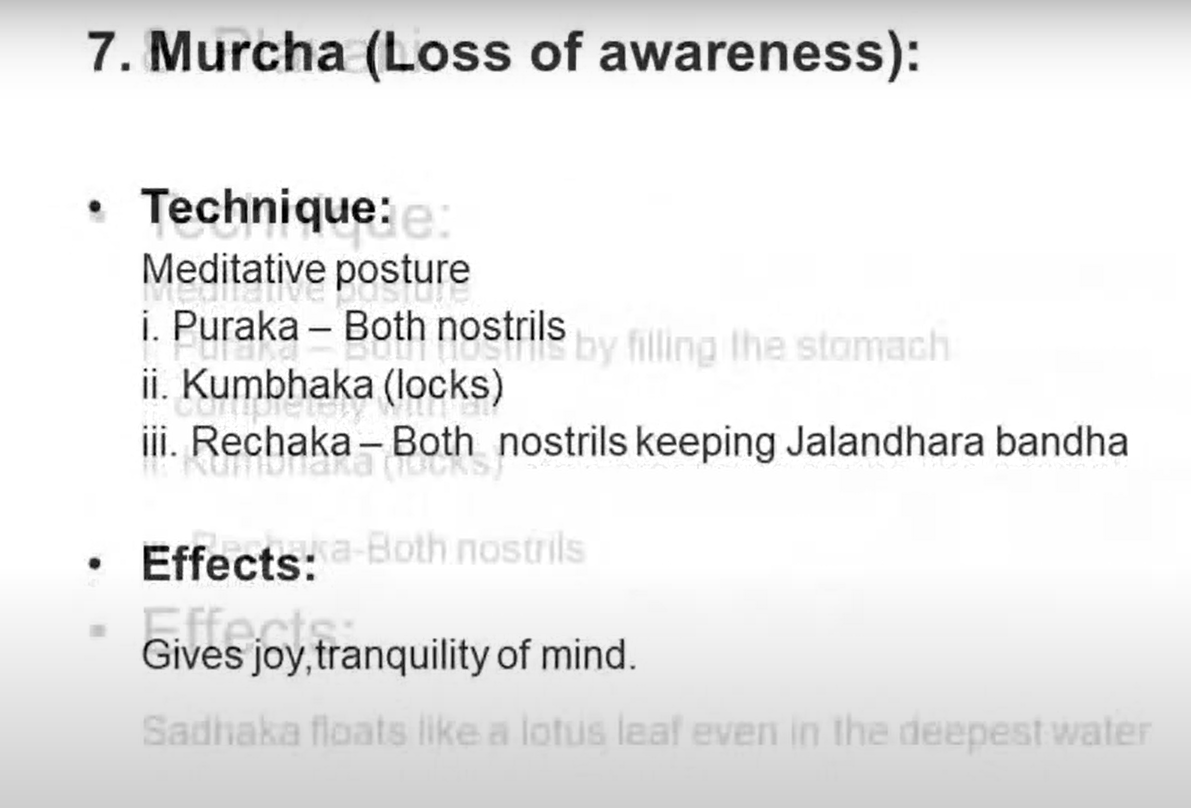
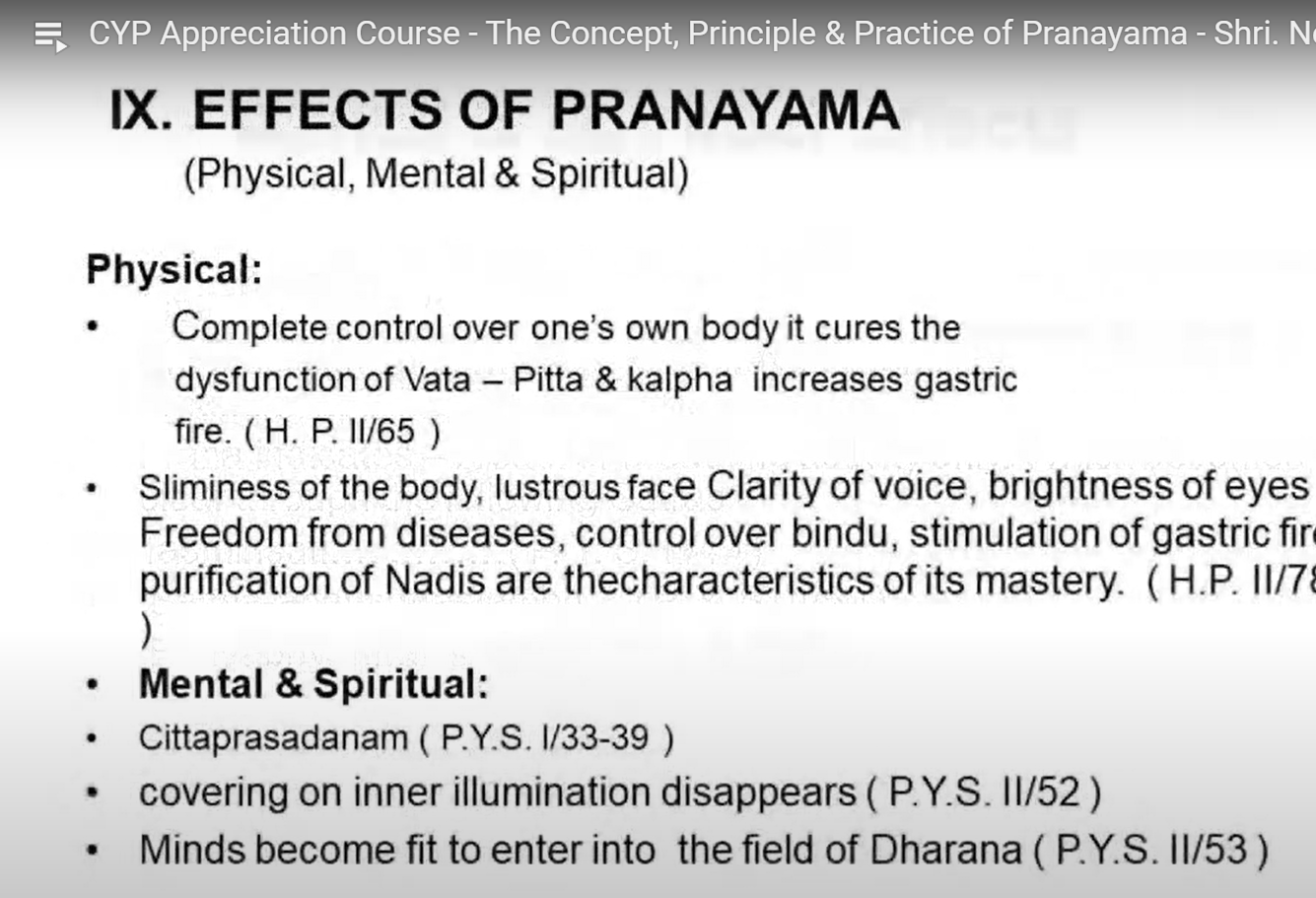
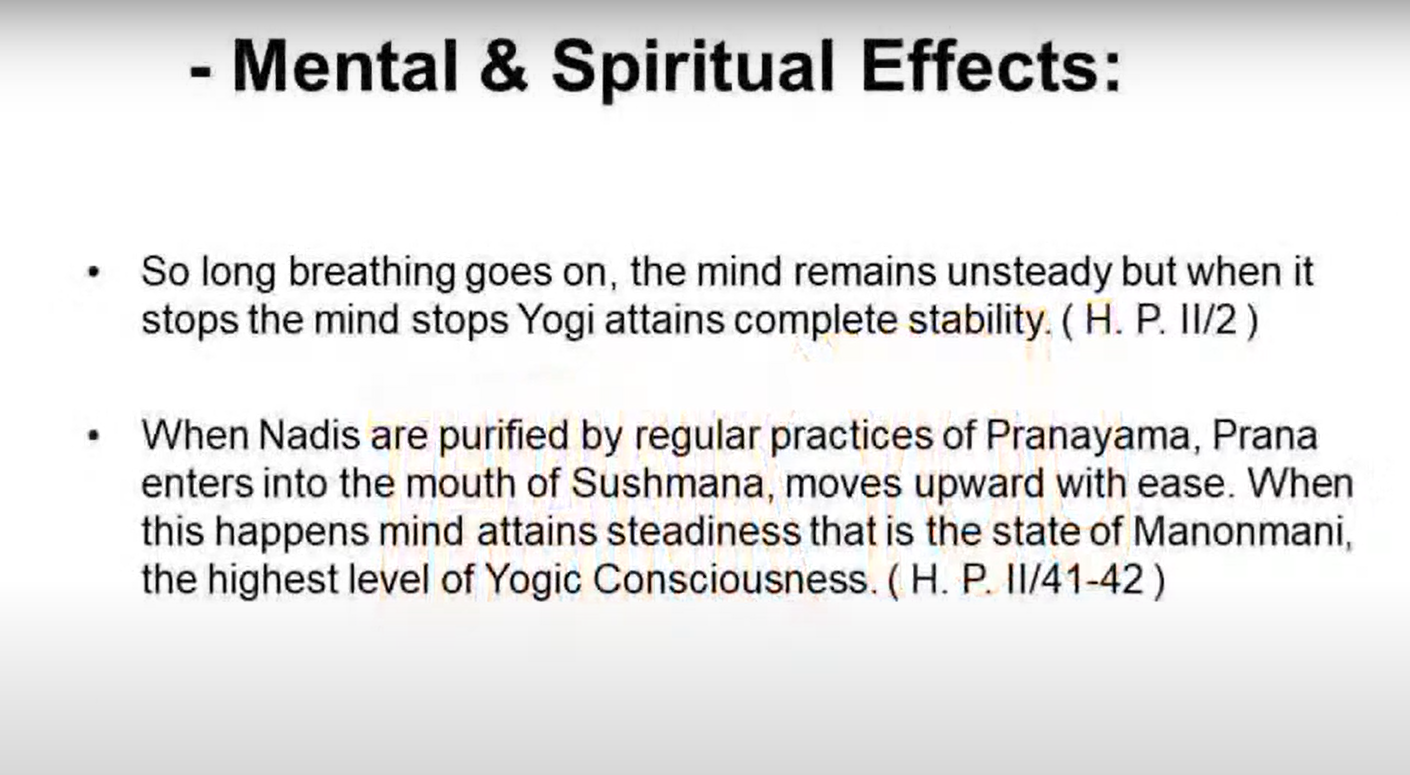
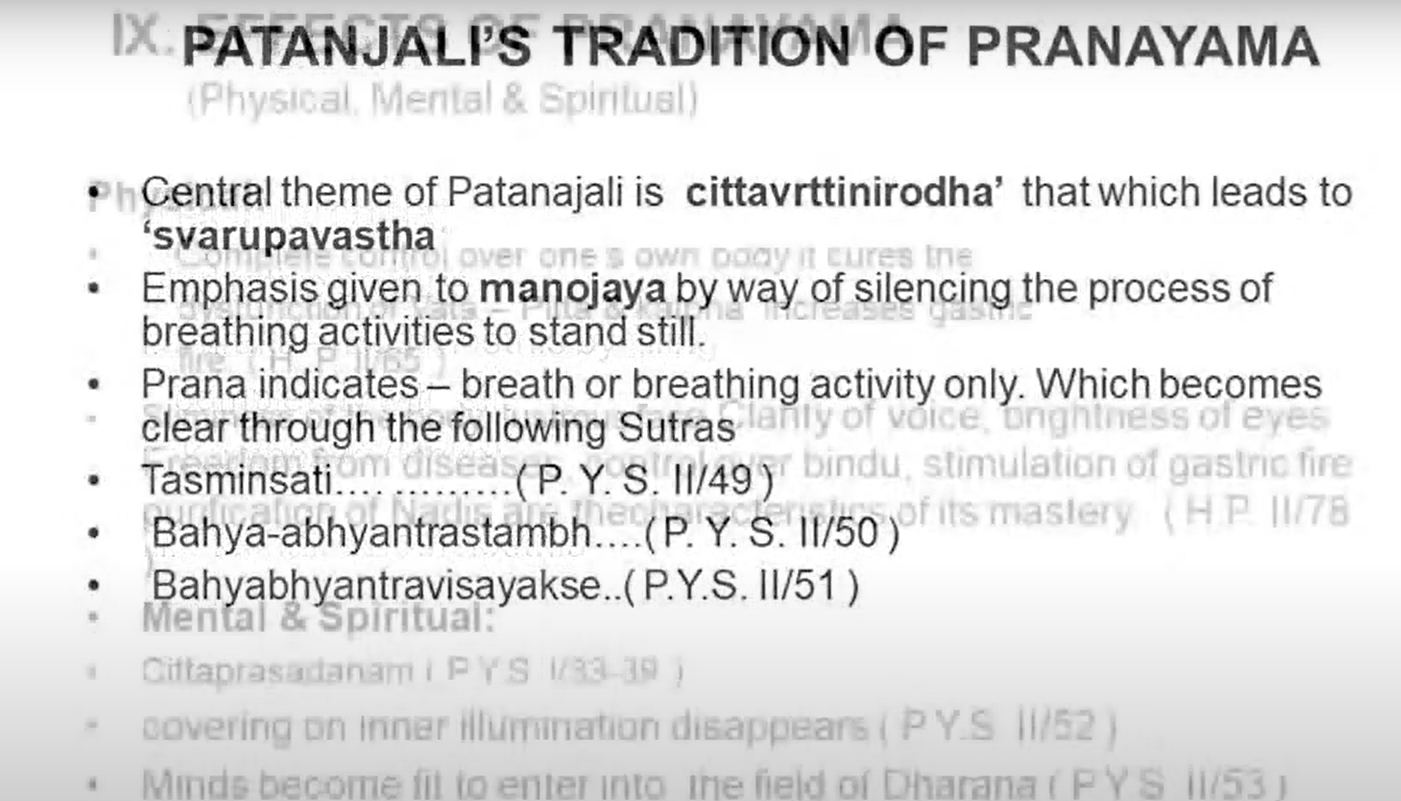
Mindfulness is the practice of living in the present moment. In mindfulness, we realize that we are not doing anything. All things happen by themselves. Anger, anxiety, depression, sadness, jealousy, etc. are our creations. These do not exist outside of us. We create all the issues, there are no issues outside us, and there are no issues in the present moment. Thinking about the past brings resentment and future thinking mainly brings anxiety. The present moment is life and it has nothing else.
Breathing happens in the present moment, which is why breathing techniques are important in mindfulness. Breath never happens in the past or future. At birth, life starts with deep breaths going inside. Life ends at death with a deep breath going out. Between this first inhalation and last exhalation is life.
Breathing practices or pranayam--
- Bring our focus to the present moment
- Gives energy
- Control the mind ( try thinking while holding the breath-- impossible)
- Helps in emotional control(number of breaths per min and breathing pattern changes with different emotions)
- Remove CO2 from the body
- Increases immunity
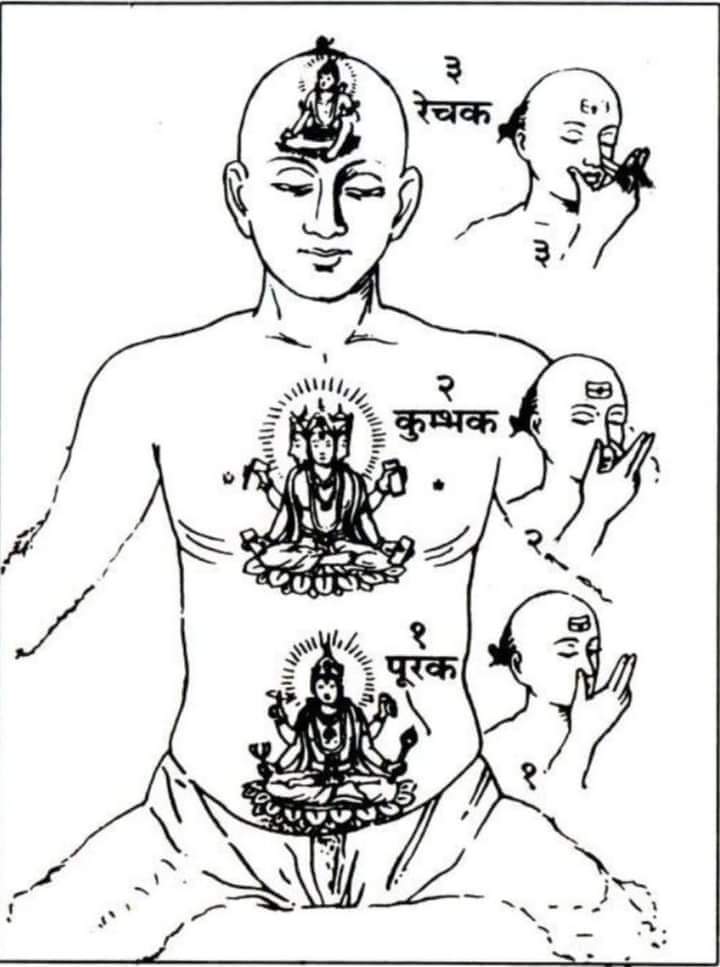
स्वर योग
प्रणायाम प्राण के आयाम पांच प्राण
प्राणों के आयाम तक पहुंच जाना ही प्रणायाम हैं।
अपनी स्वास के माध्यम से पंच प्राण के आयाम को स्पर्श करने की प्रक्रिया प्राणायाम हैं
चुपचाप एक मिनट के लिए बैठें।
आखें बंद कर लें, दृष्टि को नाक पर केंद्रित करें, पीठ सीधी रखें, और दिमाग़ को शांत करें।
एक गहरी साँस लें, बहुत धीरे-धीरे से, जल्दबाज़ी ना करें।
धीमी गति से साँस छोड़ें।
अपनी सुविधा के अनुसार 10-20 बार दोहराएं।
इस क्रम को ३०सेकेंड के अंतराल से इसके दस सेट लगाए।
कम से कम १००से २०० बार स्वास ले और निकाले बिलकुल सहज होकर। अपनी क्षमता के अनुसार, (यह क्रिया हठयोग मै आती )
प्राणायाम प्राण अर्थात् साँस आयाम दो साँसो मे दूरी बढ़ाना, श्वास और नि:श्वास की गति को नियंत्रण कर रोकने व निकालने की क्रिया को कहा जाता है। श्वास को धीमी गति से गहरी खींचकर रोकना व बाहर निकालना प्राणायाम के क्रम में आता है।
प्राणायाम सभी चिकित्सा पद्धतियों में सर्वश्रेष्ठ है क्योंकि इसके नियमित और विधिवत अभ्यास से समस्त स्नायु कोष, नस नाडि़याँ, अस्थियाँ, मांसपेशियाँ और अंग प्रत्यंग के रोग दूर होकर वे सशक्त और सक्रिय बनते हैं. इसके प्रयोग से प्राणशक्ति व जीवनीशक्ति बढ़ती है, सप्तधातुएं परिपुष्ट होती हैं ।
प्राण ऊर्जा, तेज, शक्ति है। प्राण समस्त जीवन का आधार और सार है; यह वह ऊर्जा और तेज है, जो सम्पूर्ण विश्व में व्याप्त है। प्राण उस प्रत्येक वस्तु में प्रवाहित होता है जिसका अस्तित्व है।
इससे भी अधिक, प्राण भौतिक संसार, चेतना और मन के मध्य सम्पर्क सूत्र है। यही तो भौतिक स्तर पर जीवन को संभव बनाता है। प्राण सभी शारीरिक कार्यों को विनियमित करता है, उदाहरणार्थ श्वास, ऑक्सीजन की आपूर्ति, पाचन, निष्कासन-अपसर्जन और बहुत कुछ। मानव शरीर का कार्य एक ट्रांसफॉर्मर की भांति है, जो विश्व भर में प्रवाहित प्राण से ऊर्जा प्राप्त करता है, इस ऊर्जा का आवंटन करता है और फिर इसे समाप्त कर देता है। यदि किसी व्यक्ति या कमरे में स्वस्थ, व्यवस्थित स्पंदन है, तो हम कहते हैं "यहां अच्छा प्राण है"। इसके विपरीत रुग्णता, प्राण के प्रवाह में बाधा डालती है या रोकती है। हम ज्यों-ज्यों प्राण को नियन्त्रित करने की योग्यता विकसित करते हैं, हम शरीर और मन दोनों के स्वास्थ्य व समन्वय को प्राप्त कर लेते हैं। इसके साथ ही दीर्घ और अनवरत अभ्यास के साथ चेतना के विस्तार का भी अनुभव होने लगता है।
पांच प्राण : प्राण, अपान, व्यान, उदान और समान।
प्राण
प्राण, ब्रह्माण्ड-प्राण का वह विशेष कार्य है, जो मानव-शरीर को अनिवार्य ऑक्सीजन की आपूर्ति करता है। इसकी ऊर्जा नासिका-छिद्रों से हृदय-स्तर तक प्रवाहित होती है।
स्वच्छ वायु स्वास्थ्य के लिए अत्यावश्यक है, किन्तु मात्र वायु के आधार पर ही स्वास्थ्य अच्छा होना कोई कारण नहीं है। कुछ लोग रुग्ण हो जाते हैं, यद्यपि वे बहुत समय स्वच्छ वायु में ही रहते हैं। इसके विपरीत, ऐसे व्यक्ति भी हैं जो तुलनात्मक रूप में घटिया किस्म की हवा में उपनगरों या कमरों में रहते हैं, फिर भी स्वस्थ होते हैं। हमारा स्वास्थ्य केवल बाह्य कारणों से प्रभावित नहीं होता है। स्वास्थ्य हमारी आन्तरिक अवस्था से, प्रतिरोधक-शक्ति से और आन्तरिक इच्छा - "आत्मबल"- आन्तरिक सामर्थ्य से भी अनुशासित होता है। जब 'आत्मबल' अन्दर से दृढ़ होता है, तब बाहरी शक्तियां हमें यदा-कदा ही नुकसान पहुंचाती हैं। "दैनिक जीवन में योग" का अभ्यास हमारी जीवन शक्ति को सुदृढ़ करता है। कुछ निश्चित व्यायाम विधियां विशेष प्राण-शक्ति को सक्रिय करती हैं, ये हैं भस्त्रिका, नाड़ी-शोधन और उज्जायी - प्राणायाम।
अपान
अपान प्राण शरीर के निम्न-भाग को, नाभि से पैरों के तलवों तक को प्रभावित करता है। यह प्राण निष्कासन-प्रक्रिया को विनियमित करता है। रोग जो पेट के निचले भाग को प्रभावित करते हैं- आंतों, गुर्दे, मूत्र-मार्ग, टांगों आदि को - वे सभी अपान प्राण की अवस्था का परिणाम ही होते हैं। नौलि, अग्निसार-क्रिया, अश्विनि मुद्रा और मूल-बन्ध विधियां अपान प्राण को मजबूत और शुद्ध करने का कार्य करती हैं।
व्यान
व्यान प्राण मानव शरीर के नाड़ी मार्ग से प्रवाहित होता है। इसका प्रभाव पूरे शरीर पर और विशेष रूप में नाडिय़ों पर होता है। व्यान-प्राण में कमी से ही रक्त-प्रवाह में कमी, नाड़ी संचरण में खराबी और स्नायु संबंधी गति-हीनता होती है।
व्यान प्राण कुंभक (श्वास संग्रह कर रखना) के अभ्यास से सुदृढ़ और सक्रिय होता है। प्रत्येक सहज, तनावहीन श्वास के साथ जो हम लेते हैं, उसके हर पूरक और रेचक के मध्य एक स्वत: ठहराव होता है। प्राणायाम के अभ्यास से, यह ठहराव लम्बा ही किया जाता है। हम जब श्वास को रोक लेते हैं, तब हम शरीर में ऊर्जा को सजो लेते हैं, जिसके फलस्वरूप दबाव-निर्माण होता है। इस दबाव के प्रभाव से ऊर्जा की रुकावटें खुल जाती हैं। कुंभक नाड़ी-तन्त्र को प्रोत्साहित करता है। जिस व्यक्ति ने कुंभक व महा-बन्ध विधियों को जोडऩा सीख लिया है, उसे शरीर में प्रवाहित होने वाली शान्ति के सुखद तरंग का पूरा ज्ञान हो जाता है। इस अभ्यास के बाद अच्छी तरह ध्यान लगा पाने का यही कारण है। व्यान प्राण की वर्धित प्रवाह-शक्ति से सम्पूर्ण शरीर में यह भावना उत्पन्न हो जाती है।
गहरा पूरक और रेचक एक बार करें।
फिर पूरक करें। यथा सम्भव देर तक श्वास को रोके रखें (20, 30 तक गिनती करें)
रेचक करें और कुछ समय के लिए फिर श्वास को रोक लें
इस व्यायाम को 4-5 बार दोहरायें।
इस सरल श्वास व्यायाम का लाभ जल्दी दिखाई पड़ता है और हमारी नाडिय़ां सचमुच आभारी होती हैं।
उदान
उदान प्राण वह उच्च आरोही ऊर्जा है, जो हृदय से सिर और मस्तिष्क में प्रवाहित होती है। उदान प्राण कुण्डलिनि शक्ति के जाग्रत होने पर उसके साथ होती है। उदान प्राण की सहायता से आकाशीय शरीर (पिण्ड) स्वयं को शारीरिक शरीर से अलग कर लेता है। एक दृढ़ उदान प्राण मृत्यु के चरण को सुगम कर देता है।
उदान प्राण के नियन्त्रण से शरीर बहुत हल्का हो जाता है और व्यक्ति में हवा में उठ जाने की योग्यता आ जाती है। जब उदान प्राण हमारे नियन्त्रण में होता है, तब बाह्य बाधाएं जैसे जल, भूमि या पत्थर हमें बाधा नहीं डाल सकते। योग श्वास व्यायामों का गहन अभ्यास जल पर चलने की संभावना भी देता है और आकाश में तैरने की स्थिति भी बना सकता है। फकीर जो कीलों की शैय्या पर बैठते या लेटते हैं, उनमें अपने उदान प्राण के नियन्त्रण की क्षमता होती है। योगी जो जंगलों में रहते हैं और गर्मी, सर्दी, कांटों और कीड़ों से प्रभावित नहीं होते, उदान प्राण के नियन्त्रण से ही सुरक्षित रहते हैं। उज्जायी प्राणायाम, भ्रमरी प्राणायाम और विपरीत करणी मुद्रा के अभ्यास से भी उदान प्राण सक्रिय हो जाता है।
भ्रमरी प्राणायाम विधि
कानों को अंगुलियों से बन्द कर लें और पूरक करें। नाक से रेचक करते समय भौंरे जैसी गूँज करें (मुख बन्द रहेगा)।
5-7 श्वासों के बाद निश्चल बैठ जायें और कानों को बन्द रखते हुए ही सामान्य श्वास लें। अपने आन्तरिकआकाश पर चित्त एकाग्र करें और आन्तरिक ध्वनि सुनें।
यह व्यायाम नाडिय़ों और विचारों को शान्त करेगा, एकाग्रता को बढ़ायेगा और आपको अपने स्व (आत्मा) के सम्पर्क में ले जाएगा।
समान
समान अति महत्त्वपूर्ण प्राण है, जो दो मुख्य चक्रों- अनाहत एवं मणिपुर चक्रों को जोड़ता है।
समान प्राण आहार की ऊर्जा को सम्पूर्ण शरीर में वितरित करता है। हमें सावधान होना चाहिए कि भोजन केवल हमारे शारीरिक शरीर को प्रभावित नहीं करता है, अपितु हमारे मस्तिष्क (मन) और चेतना को भी प्रभावित करता है। प्राण की गुणवत्ता (सभी प्रकार के प्राण), सीधे-सीधे हमारे खाद्य की गुणवत्ता से संबंधित है। शुद्ध, सात्विक, शाकाहारी भोजन और प्राणायाम का अभ्यास जीवन भर के लिए एक स्वस्थ और संतुलित शरीर प्रदान करेगा।
समान प्राण का मणिपुर चक्र पर प्रभाव होता है जिसका समानक तत्त्व अग्नि है। जब योगी समान प्राण पर नियन्त्रण कर लेते हैं, तब उनके अन्दर शुद्ध ज्योत होती है। जिन्होंने समान प्राण को पूर्ण कर लिया वे प्रभामण्डल से प्रदीप्त होते हैं, जो उनको भी दिखाई देता है, जिनमें प्रभामण्डल देखने की योग्यता नहीं होती।
यह प्राण अग्निसार क्रिया एवं नौलि के अभ्यास से सुदृढ़ होता है। इन दो क्रियाओं का अभ्यास पाचन समस्या और मधुमेह से बचाता है। जठराग्नि के कारणों को दूर करते हुए ये क्रियाएं पूरे शरीर को जाग्रत कर शुद्ध और स्वच्छ करती है। यह संक्रमणशील बीमारी और कैंसर का प्रतिरोध करने की क्षमता भी सुधारता है।
तुम्हारी आयुष्य है। खरगोश और कबूतर एक मिनट में 38 श्वास खर्च करते हैं, वे अधिक से अधिक 8 साल जी सकते हैं। बंदर एक मिनट में 32 श्वास खर्च करता है, वह 10 वर्ष तक जी सकता है। कुत्ता एक मिनट में 29 श्वास खर्च करता है, वह भी 14 वर्ष तक जी सकता है। घोड़ा एक मिनट में 19 श्वास खर्च करता है, वह करीब 50 साल तक जी सकता है।
मनुष्य एक मिनट में 15 श्वास खर्च करे तो वह 100 साल तक जी सकता है। अगर आधि-व्याधि के कारण अधिक श्वास खर्च करता है तो उतनी जल्दी मरता है।
हाथी एक मिनट में 12 श्वास खर्च करता है, वह करीब 110 साल तक जीता है। सर्प एक मिनट में 8 श्वास खर्च करता है, वह 120 साल तक जी सकता है। कछुआ एक मिनट में केवल 5 श्वास खर्च करता है, वह 150 साल तक जी सकता है।
कहने का तात्पर्य यह है कि हम जितने श्वास कम खर्च करते हैं उतनी आयुष्य लम्बी होती है। आयुष्य वर्ष पर निर्धीरित नहीं होती है, श्वास पर निर्धारित होती है। तुम जितने भोग में, चिंता में या हर्ष में ज्यादा जीते हो तो उतनी तुम्हारे श्वास की गति विषम होती है और जितना तुम समता में जीते हो उतनी श्वास की गति सम होती है।
जब तुम क्रोध में होते हो तब श्वास की रिदम (तालबद्धता) एक प्रकार की होती है। जब तुम प्रेम में होते हो तब श्वास की रिदम दूसरे प्रकार की होती है। जब तुम राम में होते हो तो श्वास की रिदम शांत होती है और जब काम में होते हो तो श्वास की रिदम कुछ दूसरे प्रकार की होती है।
यदि तुम को श्वासकला आ जाय, प्राणायाम की विधि आ जाय तो काम, क्रोध, लोभ आदि के समय जो रिदम चलती है उसे तुम बदल सकते हो। काम के समय तुम राम में जा सकते हो क्रोध के समय तुम शांत हो सकते हो, ऐसी कुंजियाँ ऋषियों ने दे रखी हैं। जरूरत है, केवल उस कला को जानने की।
हम जो श्वास लेते हैं वह अलग-अलग काम करने के कारण पाँच प्रकार में बँट जाती हैः प्राण, अपान, उदान, व्यान और समान। इनका कार्य है आपके श्वासोच्छवास को सुव्यवस्थित करना और शरीर के अंगों को सुचारूरूप से चलाना।
प्राण अगर तालबद्ध चलने लग जायें तो सूक्ष्म बनेंगे। श्वास अगर तालबद्ध होगा तो दोष अपने-आप दूर हो जायेंगे। अशांति अपने आप दूर होने लगेगी।
इन्द्रियों का स्वामी मन है और मन का स्वामी प्राण है। योगियों का कहना है कि अगर प्राण पर पूरा प्रभुत्व आ जाय तो तुम चन्द्र और सूर्य को गेंद की तरह अपनी इच्छा के अनुसार चला सकते हो, नक्षत्रों को अपनी जगह से हिला सकते हो ! पूर्वकाल में सती शांडिली ने सूर्य की गति को रोक दिया था।
प्राण सूक्ष्म होते हैं, प्राणायाम के अभ्यास से। जिसने अभ्यास करके प्राणों पर नियंत्रण पाकर मन को जीत लिया है, उसने समझो सब कुछ जीत लिया है।
